Free IELTS lessons signup

- Academic practice
- General practice
- Task 1 Academic
- Task 1 General
- Task 2 (essay)

IELTS Academic task 1 Lesson 1: how to write introduction?
You should start your task 1 answer by introducing the graph from your question. Just write 1-2 sentences to say what your graph shows and for what period of time (if there is one).
To do this, you need to paraphrase text from your task 1 question.
Example of good introduction :
Question : The graphs below give information about computer ownership as a percentage of the population between 2002 and 2010, and by level of education for the years 2002 and 2010.
Introduction : The bar charts show data about computer ownership, with a further classification by level of education, from 2002 to 2010.
To write a good introduction, follow these techniques :
Change introductory expressions
the graph/chart/table/diagram
- gives information about/on
- provides information about/on
- illustrates
- gives reason why (only if graph provides reasons for smth)
- explains why (only if graph provides explanation for smth)
- compares (only if several items are compared)
- compares smth in terms of smth the charts compare two cities in terms of the number of employed people.
- compares smth in year1 and year2 the graph compares the population in 2000 and 2013.
- “The pie charts provide information on the proportion of males and females working in agricultural sector.” OR “The pie charts show the proportion of males and females working in agricultural sector.”
- “The table compares five companies in terms of the number of employees.” OR “The table illustrates the number of employees in five companies.”
Paraphrasing
You can rewrite a phrase by using the word how :
- shows the number of people ... = shows how many people ...
- depicts changes in spending on ... = depicts how much changed spending on ...
You can rewrite a phrase by using synonyms :
- number of = quantity of (not interchangeable with amount of )
- spending = expenditure
- rate = percentage
- ratio = proportion
- information = data
- change can be sometimes replaced by increase , decrease or variation
- share = portion
- place = site
Time periods
- from 1985 to 1995 = between 1985 and 1995
- in 1985 = in the year 1985
- in 1985 and 1995 = in 1985 and 1995 respectively = in the years 1985 and 1995
- The table shows consumption rates from 2001 to 2004.
- The graph shows consumption rates in 2012 and 2015 respectively.

Paraphrasing in use:
See how the topic was paraphrased to make a very good task 1 introduction (picture on the right).
- Show is changed to compare
- Percentages added
- Different added
- In 2007 and 2009 → In the years 2007 and 2009
As you see, you don't have to make up a completely new introduction. Just take the given topic as a base, and change/add some details.
Practice. Choose the correct options:
- The table shows the amount of students who study abroad in 2001 and 2011. The table shows the number of students who study abroad in 2001 and 2011.
Amount or number? Note that students are countable.
- The graph illustrate China's annual growth rate of exports of goods. The graph illustrates China's annual growth rate of exports of goods.
Look at the verb that follows the word graph . Hmm, the graph should be singular, so illustrates is the correct option.
- The line graph shows how many Finnish people went to the cinema between June and October 2014. The line graph shows how much Finnish people went to the cinema between June and October 2014.
You can say how much water or how much effort (these nouns are uncountable). But people are countable, so you should use how many in this case.
- The pie charts compare the world population of 1900 with 2000 . The pie charts compare the world population in 1900 and 2000 .
You should use phrase in + year , not of + year or at + year . Moreover, it seems like you compare population with year in the first sentence.
- The bar chart gives information about average household expenditure in Japan. The bar chart shows information about average household expenditure in Japan.
You can use either gives information about or shows , but not both at the same time.
The official IELTS by IDP app is here! Download it today.
- IELTS tests IELTS Academic IELTS General Training IELTS UKVI IELTS One Skill Retake LEARN ABOUT THIS TEST What is IELTS Academic? How can I book an IELTS test? Reschedule or cancel an IELTS test Find sessions WAYS TO TAKE IELTS ACADEMIC IELTS on paper IELTS on computer IELTS Online LEARN ABOUT THIS TEST What is IELTS General Training? How can I book an IELTS test? Reschedule or cancel an IELTS test Find sessions WAYS TO TAKE IELTS GENERAL TRAINING IELTS on paper IELTS on computer LEARN ABOUT THIS TEST What is IELTS UKVI? How can I book an IELTS test? Reschedule or cancel an IELTS test Find sessions WAYS TO TAKE IELTS UKVI IELTS on paper IELTS on computer LEARN ABOUT THIS TEST What is IELTS One Skill Retake? How can I book an IELTS test? Reschedule or cancel an IELTS test READ MORE ABOUT IELTS ONE SKILL RETAKE Who accepts IELTS One Skill Retake? FIND THE RIGHT TEST IELTS for study IELTS for work IELTS for migration
Get your results
Check your provisional IELTS results online and do more.

IELTS Writing Task 2: How to write a good introduction
Introductions are an important part of a Writing Task 2 essay. They let your examiner know what to expect from your essay. That’s why we have put together a quick list of tips you can use to write an effective introduction for Writing Task 2.
Content Tags
An introduction is important to the essay because it creates an initial impression in terms of the quality of your writing. A clear, well-organised and relevant introduction will most certainly create a positive first impression on the examiner. So, what makes up an effective introduction? Let’s take a look.
Tip 1: Stop to read and analyse the question
In Writing Task 2, you need to address all the parts of the question or task in a relevant way. Because your introduction is the first step towards achieving this goal, you need to introduce your answer to all the different parts of the question. This is why it is important to take some time to read and analyse the task before you start writing, so you know exactly what you are being asked to write about.
Tip 2: Begin with a general statement and then focus in on the details of the question
Writing Task 2 questions usually begin with a general statement before focusing in on more specific points or questions about the topic. Using a similar model in your own introduction is a great way to start your essay, but make sure that your general statement is clearly related to your topic and is not too broad.
Tip 3: Use your own words
While it is perfectly acceptable for you to use the task as a guide for your introduction, make sure you do not copy material from the task.
Copying the task word-for-word shows the examiner that you have a limited range of language, which can affect your band score. Instead, change the order of the information, use synonyms, and explain more complex ideas in your own words.
It is also important not to use a memorised introduction where you insert words related to the question topic. Examiners read thousands of responses so can recognise memorised scripts.
Tip 4: State your position
In Writing Task 2, you will need to develop a position while exploring the different parts of the task. It is then important that you clearly state your position in your introduction.
Tip 5: Explain how you plan to develop your essay
Even though this strategy can be considered as optional, briefly explaining how you plan to develop the topic can help you better organise your writing. It is also a good way to let the examiner know what you’ll be covering in the essay.
Review your introduction
Don’t forget to re-read your introduction once you’ve finished writing your essay. It is common for test takers to begin their essays thinking about a specific argument, or a specific way to organise their writing but change their minds as they develop the topic. So, after completing your Writing Task 2, make sure that your final draft still matches your introduction.
Now that we have gone over some important strategies for writing a good introduction for Writing Task 2, it’s time to look at a sample introduction. Start by reading and analysing the prompt, as mentioned in tip 1. Then, carefully read the sample introduction and notice the different strategies used, which have been highlighted for you.
Sample question
The threat of nuclear weapons maintains world peace. Nuclear power provides cheap and clean energy.
The benefits of nuclear technology far outweigh the disadvantages.
To what extent do you agree or disagree?
Give reasons for your answer and include any relevant examples from your own knowledge or experience.
Write at least 250 words.
Sample introduction
General Statement:
Nuclear technology has been around for many years.
Details:
Whether this technology is used for weapons of mass destruction or as a source of energy, many are of the belief that the use of nuclear energy has more advantages than disadvantages.
Position:
In my opinion, nuclear technology can indeed be a very efficient energy source. However, nuclear weapons possess such enormous destructive power that any benefits that this technology may offer to humankind are not enough to counter its potential devastating effects.
Plan:
This essay will address why the drawbacks of nuclear technology outweigh the benefits and will include relevant examples to support this position.
Just as an effective introduction will let the examiner know what they can expect from your essay, a good conclusion will remind them of the main points presented and will summarise what you want your examiner to remember from your writing. Check our blog for our post on strategies for writing a good conclusion!
Share this article
Get familiar with taking the IELTS on computer test
How to use mind maps to build your vocabulary resource for IELTS
Grammar 101: Understanding verb tenses
How to paraphrase and boost your IELTS Writing Score
Prepare for IELTS with these 6 easy steps
Should I take IELTS on computer or paper?
IELTS on computer: Advantages, sample questions and answers
IELTS Writing Task 2: 8 steps towards a band 8
IELTS Writing Task 2: How to write a good conclusion
IELTS General Training, Writing Task 1: How to write a letter
- Useful links
- Who accepts IELTS?
- News and articles
- IELTS Masterclass
- Your IELTS results
- IELTS General Training
- IELTS Academic
- IELTS Online
- IELTS by IDP app
- Find sessions
- Check IELTS results
- Middle East
- Netherlands
- New Caledonia
- New Zealand
- Papua New Guinea
- Philippines
- Saudi Arabia
- Solomon Islands
- South Korea
- Switzerland
- Legal notices
- Privacy policy
- Cookie policy
- Copyright 2024 IDP IELTS
- IELTS Scores
- Life Skills Test
- Find a Test Centre
- Alternatives to IELTS
- General Training
- Academic Word List
- Topic Vocabulary
- Collocation
- Phrasal Verbs
- Writing eBooks
- Reading eBook
- All eBooks & Courses
- IELTS Writing Task 2
- IELTS Essay Introduction
Writing an IELTS Essay Introduction
In the writing for task 2, you must write an IELTS essay introduction , but you only have 40 minutes.
In this time you need to analyze the question, brainstorm ideas to write about, formulate an essay plan, and then write your response. Even for a native writer of English, this is a lot to do in 40 minutes!
So you need to use your time carefully . You need a good IELTS essay introduction, but one thing you do not want to do is spend too long writing it so that you end up rushing your paragraphs. Your paragraphs are the most important thing as they contain all your supporting arguments and demonstrate how good you are at organizing your ideas.
The Two Elements of an IELTS Essay Introduction
You therefore need a method to write your IELTS essay introduction fairly quickly. When you write an introduction, you should make sure you do two things:
- Write a sentence (or two) introducing the topic and giving some background facts about it
- Tell the reader what you are going to be writing about (thesis statement)
How you do this will vary depending on the question, but here is an example:
Blood sports have become a hot topic for debate in recent years. As society develops it is increasingly seen as an uncivilized activity and cruel to the helpless animals that are killed. Blood sports should be banned.
To what extent to you agree or disagree?
Sample IELTS essay introduction:
Despite the fact that killing animals for sport is popular in modern society, it remains a contentious issue. I believe that blood sports are cruel and uncivilized and so should be banned as soon as possible.
This does the following things:
- First sentence: consists of the topic plus some background facts on the topic which have been taken from the rubric.
- Second sentence: gives the writers opinion and tells us that in the essay the writer will be arguing the reasons why it is cruel.
The topic does not have to be in the first sentence, but it should be made clear somewhere in the introduction. You must always have a thesis.
Paraphrasing
Another important point - don't copy from the question! You must paraphrase (put it in your own words). To do this you can use synonyms and move the order of the sentence around.
Using some of the same words is acceptable, but don't copy whole phrases .
You can see how the question above has been paraphrased. All the information is from the question, but it has been written in a different way and has not been copied.
You can also check out a short video on this lesson:

Further IELTS Introduction Examples
Science and technology have helped the world make many advances. The Arts, such as painting, theatre and dance, to name just three examples, however, are also valuable.
What things do the Arts provide to the world that Science and Technology do not?
Societies have developed rapidly over time due to the many advances in science and technology. However, the arts are also very important and provide our world with many things that science and technology cannot.
According to a recent study, the more time people use the Internet, the less time they spend with real human beings. Some people say that instead of seeing the Internet as a way of opening up new communication possibilities world wide, we should be concerned about the effect this is having on social interaction.
How far do you agree with this opinion?
A recent study has shown that as people use the Internet more, they are spending less time with human beings. I believe that although this has increased the communication around the world in positive ways, it has also led to negative effects on the day-to-day social interaction of human beings.
Unemployment has become an increasing problem in the recent past.
What factors contribute to an increase in unemployment and what steps can be taken to solve the problem?
Over recent years, the level of unemployment has been increasing at an alarming rate in many countries around the world. This essay will discuss the reasons for this increase and consider what practical solutions are available.
Some people think children in secondary school should study international news as part of the curriculum. Others think that this would be a waste of time as there are already too many subjects for children to concentrate on.
Discuss both views and give your own opinion.
While some people are of the opinion that it would be useful to include international news as a subject in the school curriculum, others believe that this is a waste of students time because they are already overloaded with subjects to study. This essay will examine both sides of the issue.
More Task 2 IELTS Lessons:

Generating ideas for IELTS essays for writing task 2
Generating ideas for IELTS essays for writing task 2 can be difficult but complex ideas are not expected.

Writing an IELTS Essay Conclusion
The IELTS essay conclusion is the final part of your IELTS essay. This lesson guides you on how to write a conclusion quickly but effectively.
IELTS Problem Solution Essay Strategies and Tips
In IELTS problem solution essays you have to discuss a particular issue and present ideas to solve that problem.
Transitional Phrases for Essays
Learn transitional phrases for essays to get a band 7 or higher in your IELTS writing for coherence and cohesion.
Tips on How to Score IELTS Band 8 in Writing and Speaking
To score IELTS Band 8 you need to understand exactly what is in the IELTS Band Descriptors for an 8 for writing and speaking first.
How to use brainstorming and planning to generate essay ideas.
Brainstorming and planning is a key step in developing your IELTS essay. This lesson has tips on how to coming up with ideas and organising them.
Can you use Personal Pronouns in Essays for IELTS?
Learn how to use personal pronouns in essays for IELTS correctly. Can you use "I", "we" and "you"?
How to Identify the Task in an IELTS Essay
Learn how to identify the task in an IELTS task 2 essay question. This is one of the most important steps in responding to an essay question.
Improving Writing Coherence for IELTS essays
25% of the writing grade is on how you organise your essay so this lesson shows you how to improve your writing coherence.
IELTS Advantage Disadvantage Essay Tips and Strategies
An advantage disadvantage essay is one type of essay that you may get in the test. This lesson shows how to write a pros cons essay.
Requirements for IELTS Band 7 in Writing
Getting to an IELTS Band 7 is a struggle for many candidates. This lesson explains exactly what you have to do to reach this band score.
Using Pronouns to Improve IELTS Essay Coherency
Find out how to use pronouns to improve your coherency for IELTS task 2 essays.
Paragraph Writing for IELTS: Building strong arguments
This paragraph writing lesson provides tips on constructing the best paragraphs for your IELTS essay.
How to Identify the Topic of an IELTS Essay Question
In IELTS you must identify the topic of your essay as this is a key to making sure your essay is on topic.
IELTS Music Essay: Understanding a Complex Question
An IELTS essay about music is used to show you how to answer a more complex IELTS essay question that does not have a clear 'task' given to you.

IELTS Task Response - 25% of your essay grade
The IELTS Task Response criteria in the scoring makes up 25% of your band score for your essay.
The 3 Types of IELTS Opinion Essays in IELTS
IELTS opinion essays in IELTS can be placed into three types. This lesson explains the different types and how to analyse these essay questions.
Thesis Statement Tips for IELTS Essays
Your thesis statement in an IELTS essay should be written quickly and concisely. Use these tips to do that.
How to Write an IELTS Essay: The key steps
Learn key steps on how to write an IELTS Essay. This guides you on how to write a great essay plus other lessons to improve your writing skills.
Using Substitution in IELTS to Improve Writing Coherency
You can use substitution in your IELTS essays in order to improve coherency and coherence.
Any comments or questions about this page or about IELTS? Post them here. Your email will not be published or shared.
Before you go...
Check out the ielts buddy band 7+ ebooks & courses.

Would you prefer to share this page with others by linking to it?
- Click on the HTML link code below.
- Copy and paste it, adding a note of your own, into your blog, a Web page, forums, a blog comment, your Facebook account, or anywhere that someone would find this page valuable.
Band 7+ eBooks
"I think these eBooks are FANTASTIC!!! I know that's not academic language, but it's the truth!"
Linda, from Italy, Scored Band 7.5

IELTS Modules:
Other resources:.
- All Lessons
- Band Score Calculator
- Writing Feedback
- Speaking Feedback
- Teacher Resources
- Free Downloads
- Recent Essay Exam Questions
- Books for IELTS Prep
- Useful Links

Recent Articles
Decreasing House Sizes Essay
Apr 06, 24 10:22 AM

Latest IELTS Writing Topics - Recent Exam Questions
Apr 04, 24 02:36 AM

IELTS Essay: English as a Global Language
Apr 03, 24 03:49 PM

Important pages
IELTS Writing IELTS Speaking IELTS Listening IELTS Reading All Lessons Vocabulary Academic Task 1 Academic Task 2 Practice Tests
Connect with us
Copyright © 2022- IELTSbuddy All Rights Reserved
IELTS is a registered trademark of University of Cambridge, the British Council, and IDP Education Australia. This site and its owners are not affiliated, approved or endorsed by the University of Cambridge ESOL, the British Council, and IDP Education Australia.
- A Beginner’s Guide to IELTS
- Common Grammar Mistakes [for IELTS Writing Candidates]
Writing Correction Service
- Free IELTS Resources
- Practice Speaking Test
Select Page
How to Write an Introduction for IELTS Writing Task 2
Posted by David S. Wills | Jul 8, 2021 | IELTS Tips , Writing | 0
The following is an excerpt from my 2019 book, How to Write the Perfect Essay for IELTS . It is all about how to write an introduction to an essay and I felt it was important enough that I would include it here for everyone to read. If you want to see the rest of the book, you can find it on sale here .
Writing an Introduction
An essay’s introduction is incredibly important because it is the first thing that an examiner will read. In this short paragraph, you will attempt to address the topic and give a basic overview of your essay. If this is clear and relatively error-free, the examiner will be impressed and they may view the rest of your essay more favourably. Note that this is not a conscious decision and an examiner will always try to be fair. However, human nature is such that first impressions are important.
In our examples and rules above, I have explained the basics of writing an introduction. However, you might be wondering a few things:
- Do I always have to follow the same rules for writing an introduction?
- Will every essay require the same sort of introduction?
- Do I need to outline my essay in the introduction?
- Does each part of the introduction really require just one sentence?
- Is there an ideal number of words to write in an introduction?
The answer to all these is: NO. There are many possible ways to write a good introduction, and different teachers will tell you different things. What I have done so far is give you some helpful advice about writing essays. My advice is intended to give all IELTS students the best chance of scoring band 7.0 or higher by offering simple, practice advice, but there are different ways of writing a great essay.
Essentially, what you do need to do is:
- Introduce the topic.
- Assert a position and/or explain the purpose of your essay.
To do this, I think that the best way to write an introduction is to paraphrase the question and then write a thesis statement. Let’s look at these in detail.
Introducing the Topic
You should write one or two sentences at the very beginning of your essay that explain the topic. If you begin with a very general topic, you might need to write two sentences as the second one will focus on the key issue. Some teachers will tell you that you need to paraphrase the question, but while this can be helpful, it is not the best approach .
In Section II of this book, we talked about analysing the question. If you have fully analysed the question, then writing the first sentence of your essay should be pretty easy. You just need to find what the main idea is, and explain it. Let’s look at an example:
Some people say that now we can see films on our phones or tablets there is no need to go to the cinema. Others say that to be fully enjoyed, films need to be seen in a cinema. Discuss both views and give your own opinion.
My introduction to this essay would be:
In recent years, mobile technology has improved to the point that people can now watch movies in HD almost anywhere by using a phone or tablet. This development has caused some people to speculate that cinemas will soon be obsolete. However, this essay will argue against that viewpoint.
In analysing the question, I noted that it contained two contradictory statements:
- It is better to watch movies on a phone or tablet.
- It is better to watch movies in the cinema.
There is a more focused point hidden within the question:
There is no point in going to the cinema anymore.
My first sentence is extremely broad. I have started with a phrase (“in recent years”) that sets this topic within a time context then stated the main idea: the improvement of mobile technology has changed the way we view movies. Rather than make one very long, complicated sentence, I have added a shorter one that expands upon and qualifies my first. The second sentence focuses my essay by introducing item #3 from above. It states that because of these technological developments, there is no reason to go to the cinema. Essentially, my first two sentences say the same thing as the question. However, I have not exactly paraphrased it. I did not attempt to copy the question with new words. Instead, I let the idea of the question develop in my head, and then wrote down the general idea of it. I think that this is the best way to handle writing an introductory sentence.
Here’s a video about how to write a great first sentence:
Asserting a Position and/or Explaining the Purpose of the Essay
What do I mean by “asserting a position”? In Section II of this book, I talked about maintaining a clear position throughout the essay. This is important for scoring highly in Task Achievement . There are different perspectives on what this requires, with some people claiming that you only need to make your position clear in the conclusion. Others, however, say that it should be stated in the introduction. The safest and most sensible option is to state your position in the introduction, support it in the body paragraphs, and then reaffirm it in the conclusion.
Of course, not all questions require a position. Some of them just ask to explain something, like a problem and a solution. In this case, you would not need to give an opinion in the introduction. You should instead write one or two sentences announcing what you will do in the essay. In the guide to structures, I referred to these as “thesis statement” and “essay outline”. You don’t always need to give both, but they are good ways of scoring highly for Coherence and Cohesion because they help clarify the structure of your essay.
In my previous example, I only wrote “…this essay will argue against that viewpoint.” This is a sort of thesis statement. I could have expanded it to say, “The first paragraph will look at reasons why it appears that cinemas will become obsolete, while the second will explore the continued relevance of cinemas in the digital era.” This is an example of an essay outline . However, there is a slight problem with this sort of sentence. While it undoubtedly adds value to an essay, it also adds to the word count, and to the length of time taken to write an essay. It is important to finish your essay within 40 minutes and also to spend time checking for errors. As such, writing an extra sentence or two could cost additional time that could be spent elsewhere. If you struggle with finishing in time, you should probably write a shorter introduction and ensure that you finish the whole essay. Advanced students, who can easily finish in time and wish to improve their score to a band 8.0 or 9.0, would do well to consider incorporating essay outlines for an improved structure.
Another reason why we may choose to include a thesis statement or essay outline is that it improves the register of an essay. In other words, it makes it more formal . Whilst a question may ask for your opinion on an issue, writing “I think…” is less formal than writing “This essay will argue that…” By getting into the habit of writing this sort of sentence, you can reduce the number of personal pronouns and increase the formality of your essay, thereby improving its tone.
Here is an example from a problem and solution essay, which would not require a thesis statement, but would require an essay outline:
Despite the growing number of gyms and fitness centres, more and more people are leading a sedentary lifestyle in the modern society. What problems are associated with this? What solutions can you suggest?
In the twenty-first century, an unprecedented number of people are living sedentary lifestyles due to changes in our work and social habits. [DW1] This is a seriously dangerous phenomenon and greatly threatens our health and happiness. [DW2] This essay will look at the problems and solutions. [DW3]
I could have expanded it slightly:
In the twenty-first century, an unprecedented number of people are living sedentary lifestyles due to changes in our work and social habits. This is a seriously dangerous phenomenon and greatly threatens our health and happiness. This essay will first look at the problems and then explore some solutions.
By adding these small extra details, I am giving a slightly more advanced guide to the essay. However, the difference is pretty minimal. This is something to consider for people aiming to make improvements and score band 7.0 or higher.
[DW1] I have written a single sentence to introduce the topic, which essentially paraphrases the question.
[DW2] This sentence develops the idea further.
[DW3] Here, I outline in the most basic terms the function of the essay.
About The Author
David S. Wills
David S. Wills is the author of Scientologist! William S. Burroughs and the 'Weird Cult' and the founder/editor of Beatdom literary journal. He lives and works in rural Cambodia and loves to travel. He has worked as an IELTS tutor since 2010, has completed both TEFL and CELTA courses, and has a certificate from Cambridge for Teaching Writing. David has worked in many different countries, and for several years designed a writing course for the University of Worcester. In 2018, he wrote the popular IELTS handbook, Grammar for IELTS Writing and he has since written two other books about IELTS. His other IELTS website is called IELTS Teaching.
Related Posts
Analysing a Band 9 Sample Answer for IELTS Writing Task 2
July 16, 2021
How to Describe a Photo (IELTS Speaking)
September 4, 2017
What Are the Common Mistakes when Taking IELTS?
February 5, 2018
What is a Good IELTS Score?
October 3, 2022
Leave a reply Cancel reply
Your email address will not be published. Required fields are marked *
This site uses Akismet to reduce spam. Learn how your comment data is processed .
Download my IELTS Books
Recent Posts
- How to Improve your IELTS Writing Score
- Past Simple vs Past Perfect
- Complex Sentences
- How to Score Band 9 [Video Lesson]
- Taxing Fast Food: Model IELTS Essay
Recent Comments
- David S. Wills on How to Describe Tables for IELTS Writing Task 1
- anonymous on How to Describe Tables for IELTS Writing Task 1
- David S. Wills on Writing Correction Service
- James Oluwasegun on Writing Correction Service
- Daisey Lachut on IELTS Discussion Essays [Discuss Both Views/Sides]
- Lesson Plans
- Model Essays
- TED Video Lessons
- Weekly Roundup

Writing IELTS Introductions and Conclusions
In IELTS writing task 2 , the introduction and the conclusion are two of the most misunderstood paragraphs. Test takers often write too much or too little. Sometimes they struggle to write anything at all.
Many students overthink these paragraphs, especially the introduction, and try to write all the most impressive grammar and vocabulary they know.
So, just how important are the writing task 2 introduction and conclusion? What makes a solid introduction and how do you write a good conclusion? Find out below.
Introductions
The importance of the introduction.
Everyone knows that introductions are necessary for the IELTS writing task 2 essay but most people don't know why or what the introduction should include.
The introduction is truly a vital section of the essay. Without one, you will not get any higher than band score 5 in Coherence and Cohesion.
For the purposes of IELTS, your essay introduction is the examiner's first impression of your writing. It should allow the examiner to approximate where your band score might be. So, an examiner will understand, upon reading your introduction, if your IELTS essay is a 6-7, a 5-6 or a 7-8.
You will not be scored only on your introduction, of course, but it is important to write a strong introduction that is accurate, concise and uses solid grammar and vocabulary.
What the IELTS Essay introduction must contain
As mentioned earlier, many test-takers overthink the introduction and end up writing too much. What should a good introduction contain? Less than you think!
- rephrasing of the prompt
- your position
Rephrasing the prompt
Rephrasing the prompt is an important element of the IELTS Essay introduction. Not only does it show the examiner you have understood the question but it also shows your ability to successfully use novel vocabulary.
What should never be missing from the introduction is your position, yet this is frequently what keeps students from getting the band score they need.
Your position
Each IELTS writing prompt has a question or command. These include:
- Discuss both views and give your opinion
- To what extent do you agree/ disagree
- Discuss advantages and disadvantages
So, what is your position? Your direct response to any of those about commands/ questions. Your response needs to be clear and direct. Essentially, you need to directly answer the question in the introduction.
What the band descriptors say
At band 7 under Task Achievement we see, "presents a clear position throughout the response." The keyword here is throughout. Throughout means from the beginning to the end.
So, it is important that you make your position clear as early as your introduction if you hope to score 7 in Task achievement and this can be done when you answer the question in the introduction.
How do you rephrase the task?
Try using synonyms and different sentence structures to convey a similar meaning.
Do you have to rephrase every word?
You do not have to rephrase every word. Sometimes when test takers try to rephrase everything the result is very unnatural text. What you want to avoid is copying chunks of text. Chunks are phrases or groups of words.
Below is a sample IELTS writing task 2 prompt.
Communication through text messaging and other forms of instant online communication are short and basic. Some people think this will be the death of grammar and spelling. To what extent do you agree or disagree?
Sample introduction
Nowadays, across the world, most people use text messages to communicate quickly and effectively. The speed of this communication, however, carries with it the risk of losing basic writing skills. In my opinion, this is a valid concern, given the minimal opportunity we have for proper writing these days, yet correct language usage will continue.
How is the prompt rephrased?
Communication through text messaging and other forms of instant online communication are short and basic. ->Nowadays, across the world, most people use text messages to communicate quickly and effectively.
Some people think this will be the death of grammar and spelling. -> The speed of this communication, however, carries with it the risk of losing basic writing skills.
The position
The writer's position shows partial agreement and briefly explains why: In my opinion, this is a valid concern, given the minimal opportunity we have for proper writing these days, yet correct language usage will continue.
Notice that in the introduction, not all the words were rephrased: communication, text messages and writing were not rephrased. However, no chunks of words were copied from the essay prompt and novel vocabulary was used.
Does the IELTS essay introduction need anything more?
Some students believe they need to write an extra sentence in their introduction, indicating that the essay will include evidence to support their arguments.
For example: This essay will address this issue, using examples and evidence to support my opinion.
Most IELTS examiners find this kind of sentence unnecessary as it doesn't add anything vital to the introduction and many times seems like a memorised phrase.
Remember that examiners are trained to spot memorized language so use language that is fairly academic but natural in your IELTS essay .
How introductions can go wrong
See the task below:
The Internet provides us with information about life and cultures of different countries, and some people say it is not necessary to visit these countries to learn about them. To what extent do you agree or disagree with this statement? Give your opinion and relevant examples.
Here is a sample introduction:
With the internet so prevalent today, some people believe it is no longer necessary to visit countries to learn about them. The internet provides us with information about different countries. I agree completely with this statement. In this essay, I will explain my viewpoint, discussing the negatives of travel.
Why it's problematic:
- Chunks of language are copied from the prompt
- The language is choppy - sentences are not linked together fluently
- The task 2 prompt does not ask you to discuss the negatives of travel. It wants to know if the internet has made it unnecessary to visit other countries.
Conclusions
The importance of the conclusion.
A good conclusion provides closure to your IELTS writing task 2. It should restate the main position you described in the introduction and leave the reader with a thoughtful but more general idea. Without a conclusion you cannot score above a band score of 5 in coherence and cohesion.
The conclusion is the last thing your examiner reads so it needs to be concise, accurate and without superfluous information.
How to write a good conclusion
- restate your position
- end with a thought-provoking idea or prediction
Restatement of your position
In your conclusion, you must first start off with your position. In many IELTS essays this means that you must give your opinion again. This should not be written though with the same language used in the introduction or in the body paragraphs. Novel vocabulary and different grammar should be included.
Thought-provoking idea or prediction
Leave the reader with something to think about on the topic. This could be a more general statement about how the essay topic affects the world more broadly or what you think may happen in the future with the issue in the essay.
What conclusions should not contain
IELTS essay conclusions should never include new ideas. Any new ideas you want to write should be incorporated into the body paragraphs.
Below is the sample IELTS writing task 2 prompt seen previously.
Sample conclusion
To conclude, while there is a risk of diluting language through continuous use of text messaging, I believe that this can be avoided. If we, as a society, continue reading regularly and consciously, language will survive and flourish.
Why it is a good conclusion
- The conclusion is brief - only two sentences long - but it incorporates the elements necessary to score well in IELTS writing task 2.
- The position is clearly stated -> while there is a risk of diluting language through continuous use of text messaging, I believe that this can be avoided.
- There is a prediction for the future related to the essay topic -> If we, as a society, continue reading regularly and consciously, language will survive and flourish.
- Advanced vocabulary is used -> diluting, continuous, consciously,flourish
- Advanced grammar is used in both sentences.
How conclusions can go wrong
Below is a sample IELTS writing task 2 prompt seen above.
Here is a sample conclusion
To conclude, travel is expensive, dangerous and time-consuming. We should avoid traveling and spend time with our friends and family instead. Recent studies have shown that when children spend time with their parents, both recorded feelings of well-being. In the future we will spend more time with our parents.
Why it's problematic
- The writing task was not about the negatives of travel
- The writer introduces new ideas in the conclusion
- There is a prediction but it is not related to the task
- No conclusions can be drawn on the actual issue in the prompt because the response is off topic
Here is another example that is representative of a band 7
To conclude, I believe the internet provides endless sources of information about the world around us but it can never replace travel fully. No internet site or application has yet to provide the transformative experience of travel nor do I think it ever will.
- The conclusion is brief - only two sentences long - but it incorporates the main points necessary to score well in IELTS writing task 2.
- The position is clearly stated -> I believe the internet provides endless sources of information about the world around us but it can never replace travel fully.
- There is a more general, thought-provoking idea related to the essay topic -> No internet site or application has yet to provide the transformative experience of travel nor do I think it ever will .
- Advanced vocabulary is used -> transformative experience
- Advanced grammar is used .
Both the introduction and conclusion are vital components of IELTS writing task 2 . They should be brief but well-structured.
They should be concise so that you can dedicate more time to your body paragraphs. Most importantly, they should answer the question so that the position is clear.
Learn more about how to successfully write all parts of the IELTS writing task 2 through the online course at IELTSPODCAST.COM. There, you will learn tips on how to quickly and effectively write ielts essays to get the band score you need.
Alternatively, sign up for essay corrections so you can gain from our years of experience as examiners. Get detailed feedback and writing tips from an ex examiner on how to answer different types of IELTS writing tasks.
A little writing help can go a long way.
- Free Essay Band Score Evaluation
- Sign up to claim your free IELTS materials
- Jump to Band 7 or it’s Free
- IELTS Writing Evaluation
- IELTS Band Score Calculator
- Book Your Online IELTS Test
- Sample Topic Answers
- Useful Sentences
- Sample Task 2 Questions 2022
- Introduction to Paraphrasing
- Model Band 9 Essay
- Five Band 9 Words
- Model Band 7 Essay
- Differences Band 9 vs Band 7 Essay
- Band 6.5 Essay
- Academic Collocations
- Topic Sentences
- Discuss Both Views
- Tutorial: To What Extent Essays
- Paraphrasing Introductions
- Essay Structures
- Essay Plans
- Describe a Pie Chart
- Using Percentages
- Map Vocabulary
- Describe Flow Charts
- Describe a Bar Chart
- How to get Band 9
- AT 1 Sample Questions 2022
- Describe a Graphic
- GT Task 1 Questions 2022
- IELTS Vocabulary
- Google Play / Podcasts
- Apple Podcast
- Android App
- Task 2 Sample Questions
- AT 1 Questions
Company addresses: HK Office: BW ENGLISH SERVICES HK Ltd, Unit 2512, 25/F, Langham Place Office Tower, 8 Argyle Street, Mongkok, Hong Kong UK Office: BW ENGLISH SERVICES, 120 High Road, East Finchley, N29ED, London, England, United Kingdom +44 20 3951 8271 ($1/min).
IELTS Writing Task 2 Introduction and Vocabulary

- What to do and what not to do for the introduction to Task 2
- Opening/paraphrasing vocabulary terms
- Vocabulary words for stating an opinion
- Overview words and phrases
Do’s and Don’ts of Writing the IELTS Task 2 Introduction
- Write at least 60 words in your introduction
- Be as specific as possible
- Plan before you write
- Paraphrase the topic
- Clearly state your opinion in a thesis statement
- Give an overview of the essay
DON’T:
- Write too much—you need to save time and energy for the body paragraphs! Aim for a maximum of 80 words
- Restate the task question exactly as it appears in the prompt
- Try to take “both sides” in your thesis statement
- Spend more than five minutes writing the introduction on test day
- Forget to use formal language
IELTS Writing Task 2 Introduction Vocabulary
Though IELTS Writing Task 2 topics can vary widely, you can still use the same basic IELTS Writing Task 2 introduction vocabulary to introduce your ideas. Here, I’ll use the following sample prompt to show words you can use for all types of prompts, as well as examples of how you could respond to this prompt specifically.
To what extent do you agree or disagree with this statement?
Opening: Paraphrasing the Topic
First, you’ll need to restate the topic. Be careful! You want to make sure that you use different words than the original prompt.
IELTS Writing Task 2 Introduction Vocabulary That Works For Many Prompts
- Experts have hotly debated the issue of X.
- It appears that…
- It may seem that…
- Some people may think that…
- People have very divided opinions about X.
Examples for This Prompt
- Experts have hotly debated the issue of social media’s effect on human psychology.
- It appears that social media may, in some cases, have detrimental effects on human emotions.
- It may seem that social media websites, like Facebook and Twitter, have an overall negative influence on our psychology.
- Some people may think that using social media sites and apps is a benign hobby.
- People have very divided opinions about how social media affects the brain.
Stating an Opinion
Next, you need to give your opinion clearly!
- I/This essay will show that…
- I/This essay agree/s that…
- I/This essay disagree/s that…
- I/This essay will argue that…
- As I/this essay will show/argue,
- I will show that the overuse of social media can have harmful effects on how we feel and act.
- This essay agrees that using social media can negatively impact our emotions.
- I disagree that spending time on social media has any unfavorable effects on our psychology.
- This essay will argue that , in moderation, social media does not harm us, but in fact provides extensive mental health benefits.
- As I will show , use of social media sites has very little effect on human psychology, either positive or negative.
Overview of the Essay
- This essay will first…before…
- To examine this issue, this essay will examine both….and…
- Firstly, this essay will…and secondly, it will….
- To discuss this issue, this essay will both…and…
- This essay will first examine how social media affects our emotions before discussing how it affects our actions.
- To examine this issue , this essay will examine both personal and social effects of social media use.
- Firstly, this essay will discuss social media use in teenagers and secondly, it will discuss social media use in adults.
- To discuss this issue, this essay will both use examples and provide reasoning to support the point that social media use has little to no psychological effects.
Example Introduction
Let’s look at a whole introduction now. Here’s what an introduction could look like for the prompt:
Experts have hotly debated the issue of social media’s effect on human psychology. I will show that the overuse of social media can have harmful effects on how we feel and act. To examine this issue, this essay will examine both personal and social effects of social media use.
More Resources for IELTS Writing Task 2 Vocabulary
Want even more resources for IELTS Writing Task 2 introduction vocabulary? First, check out Eliot’s top tips in this video!
- Then, brush up on IELTS Writing Task 2 general vocabulary and advanced vocabulary . Or, take a look at Advantages/Disadvantages essay vocabulary if you need word ideas for this essay type.
- Make sure that you’re fully prepared to tackle all aspects of Writing Task 2 by looking at the IELTS rubric .
- Finally, take a deep dive into IELTS vocabulary for Writing Task 2 with Eliot!

Eliot Friesen-Meyers is the Senior Curriculum Manager for Magoosh IELTS and TOEFL. He attended Goshen College (B.A.), New York University (M.A.), and Harvard University (M.T.S.), gaining experience and skills in curriculum development, ESOL instruction, online teaching and learning, and IELTS and TOEFL test prep education. Eliot’s teaching career started with Literacy Americorps in Pittsburgh, Pennsylvania, and later, taught ESL programs at Northeastern University, University of California-Irvine, and Harold Washington College. Eliot was also a speaker at the 2019 TESOL International Conference . With over 10 years of experience, he understands the challenges students face and loves helping them overcome those challenges. Come join Eliot on Youtube , Facebook , and Instagram . Recent blog posts Complete Guide to IELTS Writing Task 1 Complete Guide to IELTS Writing Task 2
View all posts
More from Magoosh

Leave a Reply Cancel reply
Your email address will not be published. Required fields are marked *

Click the Pic

Writing Task 2 Introduction
Watch the video on how to write an introduction for IELTS Writing Task 2.
Introduction
IELTS candidates often see the introduction as an opportunity to impress the examiner by “discussing the issue” or trying the “academic hook”. This means they write general statement about the topic’s importance or relevance. For example...

"The future means and method of classroom interaction is a hotly debated and controversial topic that greatly impacts on all aspects of education."
Candidates write this because they have been trained to do so. However, this is IELTS writing task 2, not a high school or college assignment and this type of opening is irrelevant and certainly will not impress examiners. There are no extra points for clever or impressive opening statements.
An IELTS writing task 2 introduction should contain a paraphrase of the rubric (the task statement) and a thesis statement.
Paraphrasing the task statement shows examiners that you understand the task and what you are required to write. Do not copy from the rubric as this will be deducted from your word count.
Limit the paraphrase to 1 sentence. You can paraphrase by using...
Words and phrases that have similar meaning. Example:
Statement
believed
Changing the form of the word
Example: from verb to noun
Using different grammatical structures. Example:
Statement
Many people believe
It is claimed by many
Paraphrase of the statement
It is claimed by many that the contemporary practice of students interacting with teachers in actual classrooms is forecast to disappear by 2050.
For more discussion on synonyms and paraphrase, follow the link.
IELTS Vocabulary
Thesis Statement. After paraphrasing the statement, write the thesis statement which has 2 parts. These parts can be in any order.
1. A statement of intent or purpose - what you will do in your essay.
2. State your position (opinion) in response the instructions. For example...
To what extent do you agree with this opinion?
I strongly disagree with this statement and this essay will detail the reasons why.
Pronouns. It is acceptable to use pronouns in your thesis statement. Example:
I strongly disagree with this statement and I will detail the reasons why in my essay.
Stating a clear position is a main requirement of the Task Response criterion.
Band 7: presents a clear position throughout the response.
State your position clearly in the introduction and be consistent in following it all the way through your essay.
- Skip to primary navigation
- Skip to main content
- Skip to primary sidebar
- Skip to footer

IELTS Advantage
IELTS Preparation Courses
IELTS Writing Task 2: ✍️ Everything You Need to Know
When helping students prepare for the IELTS test, one of the biggest fears is how to do well in IELTS Writing Task 2.
IELTS Writing Task 2 is the second part of the writing test, where you are presented with a point of view, argument or problem and asked to write an essay in response. Your essay should be in a formal style, at least 250 words in length and you should aim to complete it in under 40 minutes.
IELTS Writing Task 2: Everything You Need to Know
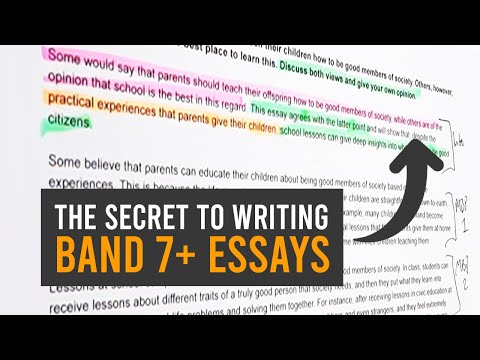
In this video, I’ll outline exactly what you must do to create an IELTS Writing Task 2 essay that could score a Band 7, 8 or 9.
It doesn’t matter if you’re new to IELTS or if you’ve failed the exam before – I’ve broken everything down into a simple 3-step process that anyone can use to improve their scores! Watch the video above to find out what they are.
5 Steps to a Band 7 in IELTS Writing Task 2
1. Understand the question.
You must understand the question before you attempt to answer it. This way, you’ll know exactly what the examiner is looking for. One of the biggest mistakes students make is not answering the question fully, which stops them from getting a score higher than a Band 5.
To analyse the question , you must first identify the question type, then identify the keywords in the question and finally identify the instructions words. This will help you understand exactly what the examiner wants you to do with the question.
2. Plan your answer.
The students who get the highest marks in Writing Task 2 always plan their answers for up to 10 minutes. Planning helps you organise your ideas and structure your essay before you write it, saving you time and helping you produce a clear and coherent essay.
3. Write an introduction.
The introduction should answer the question directly. This tells the examiner that you know what you are doing straight away and helps you write your main body paragraphs.
4. Write the main body paragraphs.
This is where you give the examiner more detail . You do this by stating your main points and supporting these with explanations and relevant examples.
5. Write a conclusion.
In your conclusion , you should provide a summary of what you already said in the rest of your essay.

4 Ways to Improve your Score in IELTS Writing Task 2
Many people know they need to improve their writing skills but don’t know how to do it. Here are 4 ways you can boost your score in Writing Task 2:
1. Understand the exam.
You must first understand what IELTS Writing Task 2 is, what you are expected to do and how to give the examiners what they want. This is the first stage and one that is often overlooked.
There are many online resources, often with conflicting and poor-quality information, so finding a reliable source of information is key.
2. Identify your weak areas.
If your car breaks down, you would try and identify which part caused the problem. If you get sick, your doctor will run tests to determine the exact cause of your symptoms.
IELTS Writing Task 2 is the same. We must first identify WHY you are not getting the score you need before we can help you improve.
However, be very careful! You wouldn’t ask the average man on the street for medical advice, so make sure you find someone who knows what they are doing and has the expertise to help you with this.
3. Fix the problems.
Now that we know what the problems are, we must fix them.
If your grammar needs work, fix those issues. If your vocabulary is lacking, work on fixing this issue.
Just as a good doctor can help you fix a medical problem, a good IELTS teacher can help you fix your specific issues.
4. Practice and get feedback.
Practice alone will not help you. It is an essential part of your preparation, but you must also get feedback on your work if you are really going to improve.
You wouldn’t try to teach yourself how to drive without an instructor, would you?
Find someone who will give you accurate and helpful feedback on your work. Otherwise, you will not be able to move to the last stage.
Now that you have understood what you need to do, identified the exact areas you need to work on, improved those areas, and received feedback on your work, you are now ready to get the IELTS Writing Task 2 score you deserve.

Writing Task 2 Structures
I want to warn you about structures because they are not a magic wand that will help you automatically get a higher score. They WILL help you, but please realise that they are just a small part of your overall score.
These structures provide a sentence-by-sentence template for all the main Task 2 question types, making your job much easier on exam day.
- Task 2 Essay Structures
Essential Writing Task 2 Skills

No matter how good your English is, you must still learn IELTS writing skills before taking the Writing Task 2 test. These helpful guides will take you through each of these skills step-by-step:
- How to Plan an Essay
Making a good plan actually saves you time when you write your essay. This guide will show you how to plan and write a clear essay every time.
- How to Think of Relevant Ideas
This guide provides 5 different methods to help you quickly think of relevant ideas that are directly linked to the question.
- How to Write a Complex Sentence
Complex sentences help you boost your score for grammar. They are actually very simple to write and are not complex at all.
- How to Paraphrase
Paraphrasing is one of the essential IELTS skills for all parts of the IELTS test. You should paraphrase the question in the very first sentence of your essay to help boost your vocabulary score in Writing Task 2.
- How to Write a Supporting Paragraph
Supporting paragraphs are the main body paragraphs and are the meat in the sandwich. This is where you provide the detail the examiner is looking for in the form of explanations and examples.
- How to Write a Thesis Statement
A thesis statement tells the examiner your opinion. Many IELTS Writing Task 2 questions specifically ask for your opinion, and if you don’t write it clearly, you have not answered the question properly. This article shows you how, where and when to give your opinion.
How many words should I write?
Around 250 words? Exactly 250 words or over 250 words? How many words over? How do I know how many words I have? Will I lose marks if I write too many words? This article answers all those questions.
- How to Understand and Analyse Any Question
A critical part of answering any question. This article shows you how to break down any Task 2 question and identify the keywords, micro-keywords and instruction words to help you answer the question effectively.
- How to Write a Great Introduction
The introduction is the first thing the examiner reads; therefore, we must give them a good first impression. I share a very specific sentence-by-sentence structure in this article to help you write introductions quickly and effectively.
- Task 2 Marking Criteria
Do you know how Task 2 is marked? What is the difference between a Band 5 and a Band 8 answer? This article breaks down the marking criteria and explains it in simple language so you can give the IELTS examiners exactly what they want.
- How to Write a Conclusion
A good conclusion should be a summary of your main points. The conclusion is the last thing the examiner reads, and if you can write a good one, you will leave them with a very good impression.
- Using Examples
Each of your supporting paragraphs should have a specific example that supports and illustrates your main point. This is an essential skill to learn if you want to get one of the higher band scores.
- Cohesive Devices
Cohesive devices (sometimes called linking words) are one of the most misunderstood and misused elements of writing. Therefore, you must learn how to use them and when to use them.
- The Danger of Synonyms
While synonyms are very important, they can also really reduce your mark if used incorrectly.
- Paragraphing and Editing
This article will show you how to make your writing as clear and as easy to read as possible. It will also advise you on whether to use a pen or pencil.
- IELTS Writing Task 2: 8 Steps to Success
Read this blog now to access our 61-page Task 2 strategy.
- IELTS Writing Tips
I have compiled these tips after years of teaching IELTS, and all of them have been approved by IELTS examiners.
- Coherence and Cohesion
This is a video lesson that shows you in practical terms how to improve your coherence and cohesion score.

Writing Task 2 Common Topics

Knowing the common topics can help you prepare for the test more efficiently. Here are the 10 most common topics over the last few years. Studying hard is great, but don’t forget to study smart.
The article below will show you the top 10 most common IELTS topics.
- Most Common Task 2 Topics
Full IELTS Writing Task 2 Practice Lessons

Here are some lessons that I have used when teaching students about IELTS Writing Task 2. I have changed them so that you can easily learn from home. They are very long but contain all the necessary information combined with the skills above.
- Agree or Disagree (Opinion) Lesson
In this lesson, we look at how to tackle an ‘agree or disagree’ question. Many people worry about whether to take one side of the other or discuss both sides. Additionally, people also worry about how to deal with ‘To what extent’ question types. We allay all of these fears in this lesson.
- Discussion Essay Lesson
‘Discuss both views’ questions often confuse people because you are asked to do many things in one essay. As such, it is very important to remember that the question asks you to discuss BOTH views AND give YOUR opinion.
- Problem and Solution Essay Lesson
These questions are much easier than you think. You probably discuss problems and solutions in your day-to-day life all the time. Keep it simple.
- Advantages and Disadvantages Lesson
There are a couple of different types of advantages and disadvantages questions. This lesson will show you how to answer them.
- Writing Task 2 Exercise with Video
Writing is a skill, and just like any other skill, it is important to practice to improve.
- From Band 6.5 to 8 Demo Lesson
This is my most comprehensive free lesson on IELTS Writing Task 2. We show you how we took one VIP student from Band 6.5 to an amazing 8.
Sample Answers
You must have some good examples to compare your writing and see if you are on the right track. Click the link below for lots of sample answers and over 100 questions.
Task 2 Sample Answers
- Agree or Disagree Sample Essays
- Task 2 Band 9 Sample Essay
- Latest Real Task 2 Questions
- Official Sample Test Questions
- Cambridge Sample Questions
- Free Practice Test
- How To Use Task 2 Samples
- Recent Confusing Questions
- IELTS Writing Practice Guide
IELTS Writing Task 2 Essential Information
- You must write an essay in response to a question.
- You must write 250 words or more.
- Task 2 is worth 2/3 of your total mark on the Writing test.
- You should spend around 40 minutes on this part of the test.
- General Training and Academic are essentially the same for Task 2. However, they are different for Task 1.
- There are certain types of questions that you will be asked, for example, opinion, discussion etc. See below for more detail on these.
- Task Achievement (25%)
- Coherence and Cohesion (25%)
- Lexical Resource (25%)
- Grammatical Range and Accuracy (25%)
Grammar and Vocabulary

Grammar is one of the four things you will be marked on in the Writing Task 2 test. Finding out what your common grammar mistakes are and then fixing them is a very powerful way to boost your score in this area. Here are some common grammar mistakes I have found after making hundreds of tests.
- Top 10 Grammar Mistakes
For most IELTS students, the problem is not grammar in general. In fact, it is usually just 1-2 problem areas. Therefore, when you fix these main weaknesses, you’ll be able to improve your grammar and your writing score dramatically.
- Using Personal Pronouns
Hint- They aren’t as big of a deal as you think.
See the interactive tool below for the answers to the most commonly asked questions we receive about IELTS Writing Task 2:
IELTS Writing Task 2 FAQs
How can i improve my writing.
You will find all the resources you need on our Writing Task 2 page. Click the link below:
Writing Task 2
We also have two Task 2 courses for those that need to improve their Task 2 skills and strategy. They are both based online and completely free of charge. Learn more about them below:
Task 2 5 Day Challenge
Task 2 Essay Builder
If you need serious help or personalised feedback, you should check out our VIP Course. There is a waiting list, but you can add your name here:
How can I get a Band 7, 8 or 9?
The answer to this question is different for every individual IELTS student, as it depends on a number of factors, including your work ethic, English skills and exam strategy. You'll find a guide to answering this question in this article
If you need serious help with improving your IELTS scores, you should check out our online writing course. There is a waiting list, but you can add your name by clicking the link below:
Can you correct my writing?
Please click the link below and it will give you all the information you need about our writing correction service:
Writing Correction Service
Do you have any sample answers?
Yes, you will find them at the link below:
Will using 'high level' or 'academic' words help me improve my score?
Probably not.
Read my recent article about IELTS vocabulary here:
5 Things You Need to Know about IELTS Vocabulary
Can I use idioms?
No, you should not write idioms for Task 2.
Can I use personal pronouns?
You should avoid using personal pronouns, but it is fine to use them when giving your personal opinion.
Do you write a conclusion for Task 2?
Yes, it is very difficult to get a good score in Task 2 if you haven't finished your essay with a conclusion. You will find an in-depth lesson on conclusions here:
How to Write an Effective Task 2 Conclusion
How many paragraphs should I write?
Most IELTS task 2 essays follow the same basic four paragraph structure:
- Introduction
- Supporting Paragraph 1
- Supporting Paragraph 2
However, you can find more comprehensive help with structuring your Task 2 essays here:
5 Day Challenge
Do I need to plan my essay?
I would highly recommend planning your essay. A good plan acts like a map that guides you through the essay, ensuring that you give the examiner exactly what they need to award you the score you need. You can find help with planning your essays here: How to Plan an IELTS Essay
You must write at least 250 words in Writing Task 2.
I would suggest that you aim to write around 270-280 words in total. Aiming for 20-30 words more than the required amount makes you more likely to reach the word limit without setting an unrealistic goal.
Will I lose marks if I don't write enough words?
Yes, if you don't write the required number of words, you will lose marks in 'Task Achievement' for not answering the question fully. Read more here .

Can I use contractions?
No, should not use contractions when you are writing an academic essay.
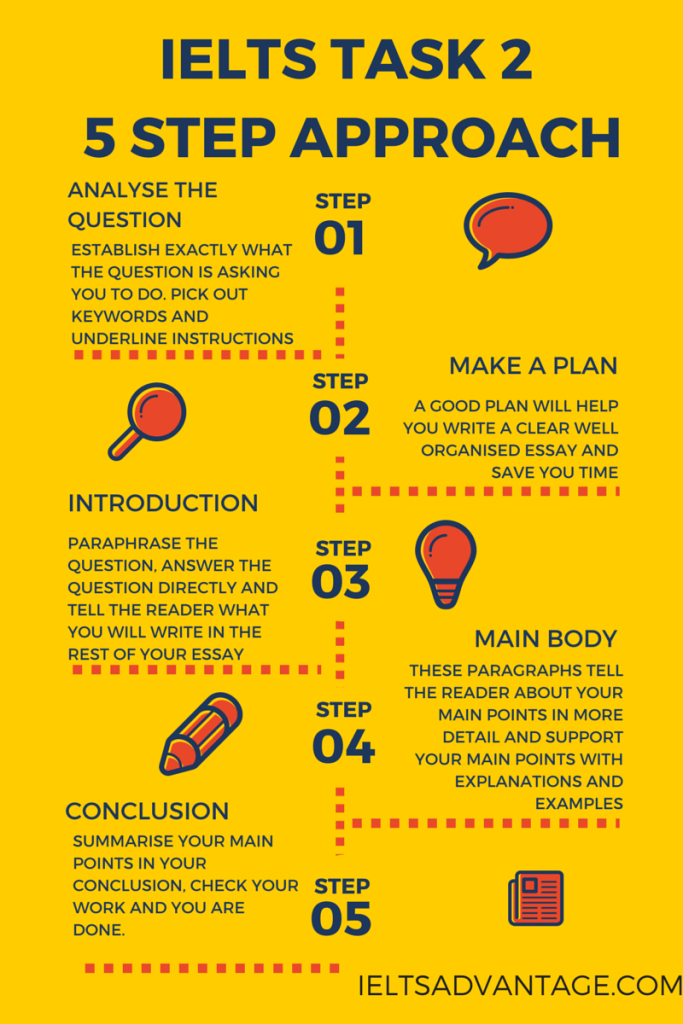
- Practice Test
- Useful Tips – Tricks
- Full Writing Review
- General Writing Task
- Writing Task 1
- Writing Task 2
- Writing Exercises
- Writing Sample – Topics
- Writing Vocabulary
- Speaking Vocabulary
- Intro Question
- Speaking Part 1
- Speaking Part 2
- Speaking Part 2 – Audio
- Speaking Part 3
- IELTS Books
- Recent Exams
- IELTS Vocabulary
- Essay from Examiners
- IELTS Ideas
IELTS App - For Mobile
Ready for the IELTS exam with our IELTS app. Over 2 million downloads

Popular Last 24h
Ielts speaking part 1 : weekends (question-answer), [pdf] master ielts essays for ielts writing task 2, ielts speaking part 1: topic sunshine, describe an important historical event in your country, cue card 2020 #37: describe a place full of colour, two-way discussion : status & ambition, pie charts #25: the charts give information about world forest in five different regions.
- IELTS Test/Skills FAQs
- IELTS Scoring in Detail
- Forecast Speaking – 2023
- List IELTS Speaking Part 3
- List IELTS Speaking Part 1
- IELTS Writing 2023 – Actual Test
Our Telegram
Join our community for IELTS preparation and share and download materials.
The information on this site is for informational purposes only. IELTS is a registered trademark of the University of Cambridge ESOL, the British Council, and IDP Education Australia. This site and its owners are not affiliated, approved or endorsed by University of Cambridge ESOL, the British Council, or IDP Education Australia.
Latest Articles
Ielts speaking part 3: topic teamwork, describe a time when someone did well in a team, writing task 1: languages learned by two genders, most popular, describe a film that made you laugh, describe a person whom you met for the first time and made you happy, topic: experience is the best teacher, describe something difficult you would like to succeed in doing, in many countries,today there are many highly qualified graduates without employment..
ieltspracticeonline All Rights Reserved
- Login Candidate Login Branch Login Node Login
Register for IELTS
Ielts writing task 2 - tips for crafting a strong introduction and conclusion.

Crafting a compelling introduction and conclusion is very important in IELTS Writing task 2 , as they serve as the gateway to engage the reader and leave a lasting impression. A strong introduction captures the reader's attention, establishes the topic's relevance, and presents a clear thesis statement, while a well-crafted conclusion provides a concise summary of the main points and offers a thoughtful final perspective. By following effective strategies and following essential guidelines, you can improve your IELTS Writing performance and maximise your chances of achieving success in this crucial section.

Tips for writing a strong introduction in the IELTS Writing task 2
Here are the 5 tips for you to consider when practicing writing a good introduction on the IELTS Writing task 2 :
Tip 1: Thoroughly read and analyse the question
To effectively address all aspects of the question or task in a meaningful manner, it is essential to dedicate time to carefully read and analyse the prompt. Your introduction acts as the initial step towards accomplishing this objective, as it introduces your response to each component of the question. Therefore, taking a moment to comprehend and dissect the task before commencing your writing allows you to fully grasp the precise focus and requirements of the prompt, enabling you to provide a comprehensive and relevant answer.
Tip 2: Start with a general statement and focus on the specifics of the question
In most instances, Writing task 2 usually starts with a general statement that gradually narrows down to specific points or inquiries pertaining to the given topic. Using a similar approach in your introduction can be an effective method to initiate your essay. However, it is crucial to ensure that your general statement maintains a clear connection to the topic and avoids being overly broad.
By striking the right balance, you can provide an engaging introduction that captures the reader's attention while remaining focused on the task at hand.
Tip 3: Use your original language
While it is undoubtedly acceptable for you to use the task structure as a guide for your introduction, it is important to avoid copying its content. Directly replicating the content raises concerns about your language proficiency and may impact your band score negatively.
Instead, try to rephrase the information, rearrange its structure, use synonyms, and express intricate concepts using your own words. Moreover, it is essential to steer clear of using memorised introductions that involve inserting preconceived phrases related to the question topic.
Skilled examiners evaluate numerous responses, enabling them to identify scripted responses, so prioritising originality should be your first concern when writing an introduction.
Tip 4: Clearly express your stance
When approaching the IELTS Writing task 2, it is crucial to delve into the various aspects of the task. Consequently, it is essential to express and state your opinions in the introduction.
Tip 5: Outline how you plan to approach your essay
While this approach may be seen as an option, providing a concise explanation of how you intend to expand on the topic can assist in structuring your writing effectively. Additionally, it serves as a helpful guide for the examiner, offering insight into the content you will address in your essay.
Review your introductory paragraph
Remember to reread your introduction after completing your essay. It is common for test takers to initially start with a specific argument or organisational structure, but as they explore the topic, they may change their perspectives. Hence, once you finish Writing task 2, it is crucial to ensure that your final draft aligns with your introduction.
Now that we have covered essential techniques for crafting a strong introduction in Writing task 2, let's proceed to examine a sample introduction. Begin by reading and analysing the prompt, as discussed in tip
Then, carefully examine the sample introduction, paying attention to the highlighted strategies.
Sample question
Give reasons for your answer and include any relevant examples from your own knowledge or experience.
Write at least 250 words.
Sample introduction (Answer)
General statement:.
Nuclear technology has been around for many years.
Whether this technology is used for weapons of mass destruction or as a source of energy, many are of the belief that the use of nuclear energy has more advantages than disadvantages.
In my opinion, nuclear technology can indeed be a very efficient energy source. However, nuclear weapons possess such enormous destructive power that any benefits that this technology may offer to humankind are not enough to counter its potentially devastating effects.
This essay will address why the drawbacks of nuclear technology outweigh the benefits and will include relevant examples to support this position.
Similar to how a well-crafted introduction informs the examiner about the content of your essay, a strong conclusion serves to reinforce the key points presented and provides a summary of the essential aspects you want the examiner to retain from your writing. Be sure to read further for insightful information on effective strategies for composing a compelling conclusion!
Tips for writing a strong conclusion in the IELTS Writing task 2
Tip 1: connect your conclusion to the introductory paragraph.
Consider your introduction and conclusion as integral parts of a cohesive whole, as they should be closely intertwined. Ensure that you:
- Revisit the concepts or themes you initially introduced
- Provide additional perspectives gained from exploring the body of your essay.
Tip 2: Summarise the primary arguments of your essay
In your conclusion, it is crucial to offer a concise overview of the key points discussed in your essay. However, it is essential to avoid repetition. Instead, demonstrate to the examiner how your arguments and the supporting evidence seamlessly interconnect.
Tip 3: Steer clear of repeating things
While summarising the primary points of your essay, refrain from echoing the language used in your body paragraphs. Try to imply diverse vocabulary and sentence structures to avoid repetitive patterns. This approach will demonstrate to the examiner your ability to utilise a broader range of vocabulary and grammatical constructions.
Tip 4: Express your personal viewpoint
When undertaking Writing task 2, it is important to present your opinion in the form of an essay. If you reach the concluding paragraph and realise that you have omitted your viewpoint, ensure that you use it in your conclusion to ensure clarity.
Tip 5: Avoid introducing new arguments
Ensure that your conclusion does not introduce fresh points. Remember that the purpose of your closing paragraph is to provide a sense of finality to your essay, rather than introducing novel ideas.
To Implement these tips into practice
After exploring various strategies for crafting a compelling conclusion, it is crucial to understand how these techniques work together to seamlessly conclude an essay. To illustrate this, let's examine a sample question, introductory paragraph, and conclusion. Observe how to use all five tips to create a cohesive ending.
Sample conclusion (Answer)
Nuclear technology is extremely dangerous. Even though nuclear weapons have only been used twice, in the Japanese cities of Hiroshima and Nagasaki, evidence from these actions, as well as from nuclear accidents such as the Chernobyl disaster, are irrefutable proof of the disastrous effects of nuclear technology. Even in the absence of nuclear accidents, nuclear power inevitably produces radioactive waste, which is severely damaging to our bodies. Our best protection against these dangers is to simply not use nuclear technology. Instead, we should look for alternative ways to produce sustainable energy and achieve world peace by spreading a message of tolerance, kindness, and non-violence.
If you review the main points in the example conclusion above:
- The destructive power of nuclear weapons
- The disastrous consequences of nuclear disasters
- The harmful effects of radioactive waste
You will see the writer reminds the examiner (reader) of the importance of their main ideas while summarising how this point fits well with the examples provided in the body of the essay.
To finish, you can see how the writer highlights their proposed course of action, which helps the essay end on a positive note.
Helpful resources
- IELTS preparation videos
- IELTS preparation guide
- Join IELTS webinar Series
Book your IELTS test

Book your IELTS test today
Ielts on computer.

Book IELTS on computer
Related blogs.
Tips to overcome nervousness and build confidence
We understand that on the day of the test, it's common for test takers to feel nervous about interacting with the examiner.
Understand the question types in the IELTS Speaking test
The International English language test system (IELTS) Speaking test consists of three parts, each with different question types.
IELTS Reading test – Excel in ‘true, false’, ‘not given’ questions
The IELTS Reading test assesses your ability to comprehend and analyse written texts, and one question type that often challenges test takers is the true, false, not given (TFNG) format.
Password Changed successfully
- Skip to primary navigation
- Skip to main content
- Skip to primary sidebar
IELTS Training with Jonathan
Helping Busy People Succeed in IELTS.
How to write a strong Introduction for IELTS Task 1
By ielts-jonathan.com on 1 June 2022 1
Writing an introduction for IELTS Task 1
The introduction is the first section that the examiner sees when your writing is marked.
It is important to create a good impression in terms of language and purpose .
There are often two simple points to make when writing an IELTS Task 1 introduction; namely,
what is the point of the information and what is the numerical information .
So, an introduction should explain what the chart/graph or map shows , for example, the type of graph, the unit of measurement, a summary of the information and the categories, the place and the time .
To do this, there is a formula you can generally follow.
What to write in an Introduction
The graph type & shows/compares & unit of measurement & what & categories & place & time
For example, let’s look at the attached visual
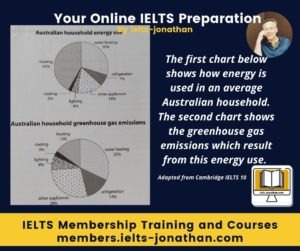
Looking at the graph, we can observe that
The graph type = The two pie charts
shows/compares = compare
unit of measurement and subject = how energy is used – emissions from energy use
categories = of six categories – –
place = in Australia
time = no time date is given
The two pie charts compare how energy is used and the emissions from energy use over six categories in Australia
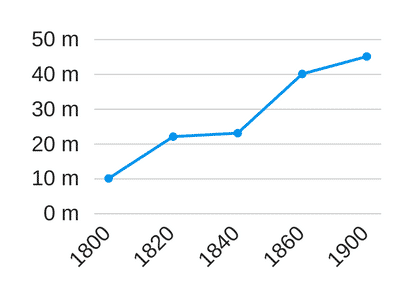
Introductions For Single images
If your question is a single visual, the most important thing to do in your introduction is to state what it shows and pay attention to the subject and verb agreement .
You can obtain this information from the legend on the pictorial and from the question itself.
Here is an example question from IELTS.
The graph presents the energy consumption by a typical British household .
An example sentence that you could rewrite and use for your introduction could be:
The chart shows how energy is used in an average household in the United Kingdom…
Introductions for more than one image
When the question features two graphs, for example, then you should write one sentence but write about each pictorial separately and state what each shows.
Pay attention again to the subject and verb agreement
As before, this is obtainable from the legend on the pictorial and from the question itself.
The first graph presents the energy consumption by a typical British household. The second graph presents how much consumption is generated for renewable energy.
This is the example sentence rewritten:
The first bar chart illustrates how energy is used in an average United Kingdom household…, and the second chart shows how much of that energy comes from renewable energy sources….
The charts illustrates how energy is used in an average United Kingdom household and how much of that energy comes from renewable energy sources….
How to write the introduction
As you can see, writing an introduction sentence for Task 1 can be relatively simple.
You will need to practice this to get better so I have provided the steps for you to follow.
Remember, you will also need to practice writing for different topics and get used to reading the questions carefully even if you follow my advice.
For a Single Graph
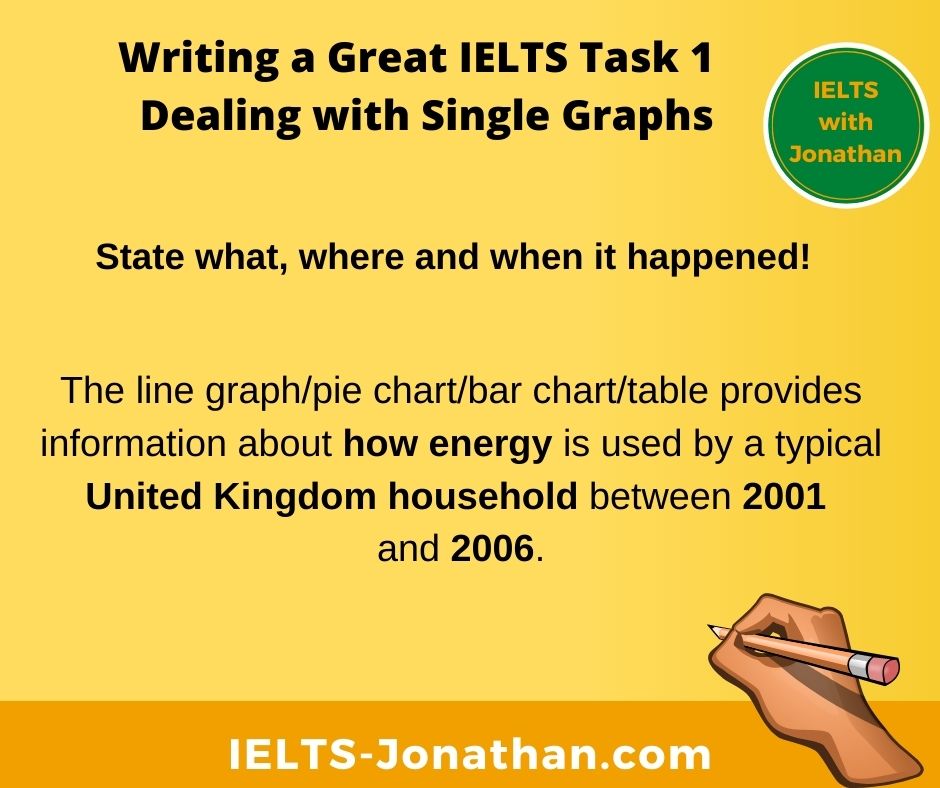
Use this rule:
The line graph/pie chart/bar chart/table provides information about … (state what happened, where it happened and or when it happened)
Step One – State what happened
The line graph/pie chart/bar chart/table provides information about how energy is used
Step Two – State where it happened
The line graph/pie chart/bar chart/table provides information about how energy is used by a typical British household
Step Three – State when it happened
The line graph/pie chart/bar chart/table provides information about how energy is used by a typical United Kingdom household between 2001 and 2006.
For Double Graphs
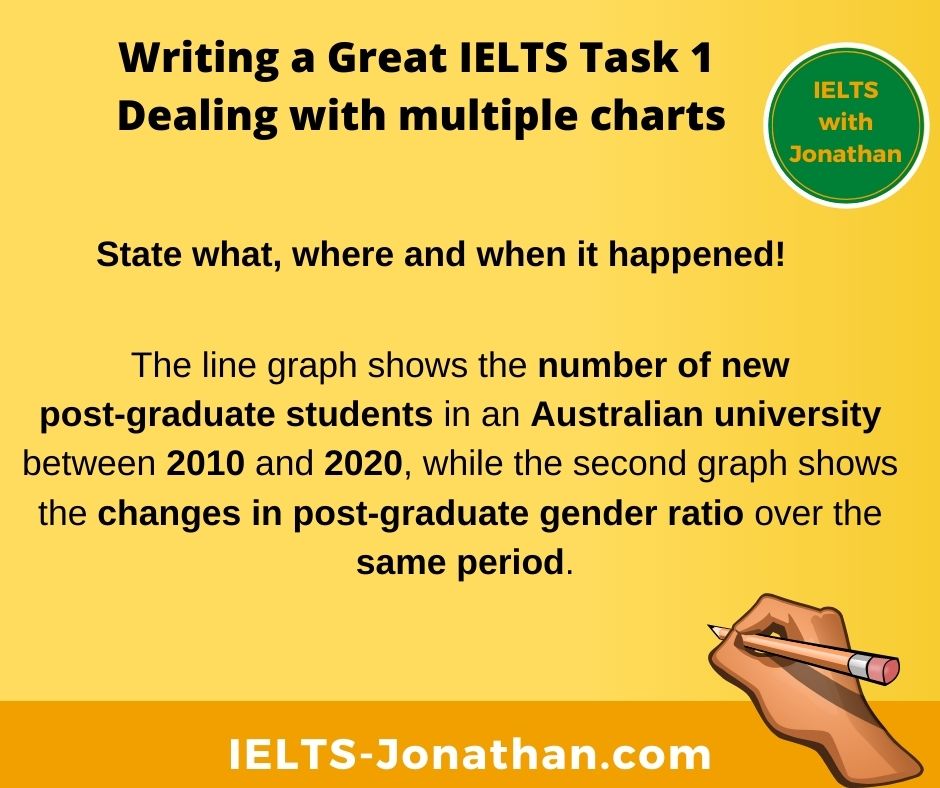
Use the same rules, but apply these to both graphs.
The line graph/bar chart/pie chart/table provides information about … ( state what happened ,where it happened and or when it happened) while the pie chart/table/bar chart/line graph indicates (state what happened ,where it happened and or when it happened)
The line graph shows the number of new post-graduate students in an Australian university between 2010 and 2020 while the second graph shows the changes in post-graduate gender ratio over the same period .
IELTS Paraphrasing an Introduction
Never just copy the title and use this for you introduction.
If you do this, the examiner will just ignore the introduction.
Use the information IELTS gives you, but put it into your own words.
One way you can paraphrase is by changing verbs into nouns and nouns into verbs .
Although these examples are from the body of an essay, they illustrate the principles of paraphrasing .
The UK invested more money than other countries in the EU. The investment by the UK was more than other countries in the EU. India consumes more energy for renewable solar than other countries. The consumption of renewable solar energy is highest in India than in other countries.
and this is from an introduction
The tables show the total investment into to renewable energies of five countries between 2010 and 2020. The information shows how much 5 countries invested in green energy production over one decade.
Turn Active sentence into Passive sentences
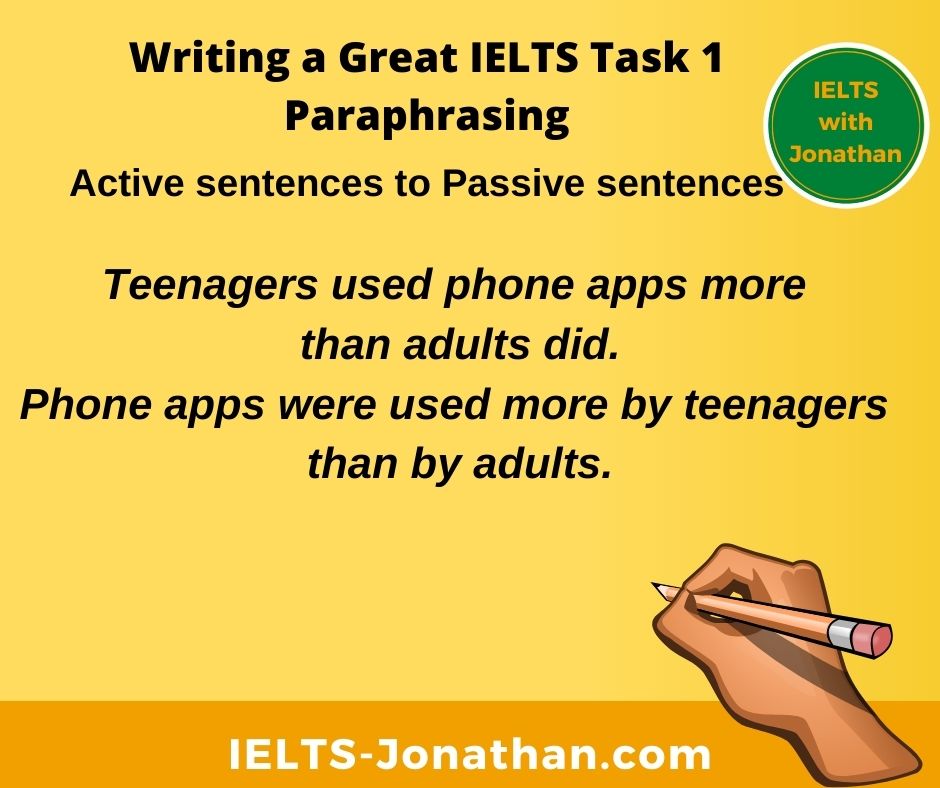
Teenagers used phone apps more than adults did. Phone apps were used more by teenagers than by adults.
Use Synonyms and Antonyms
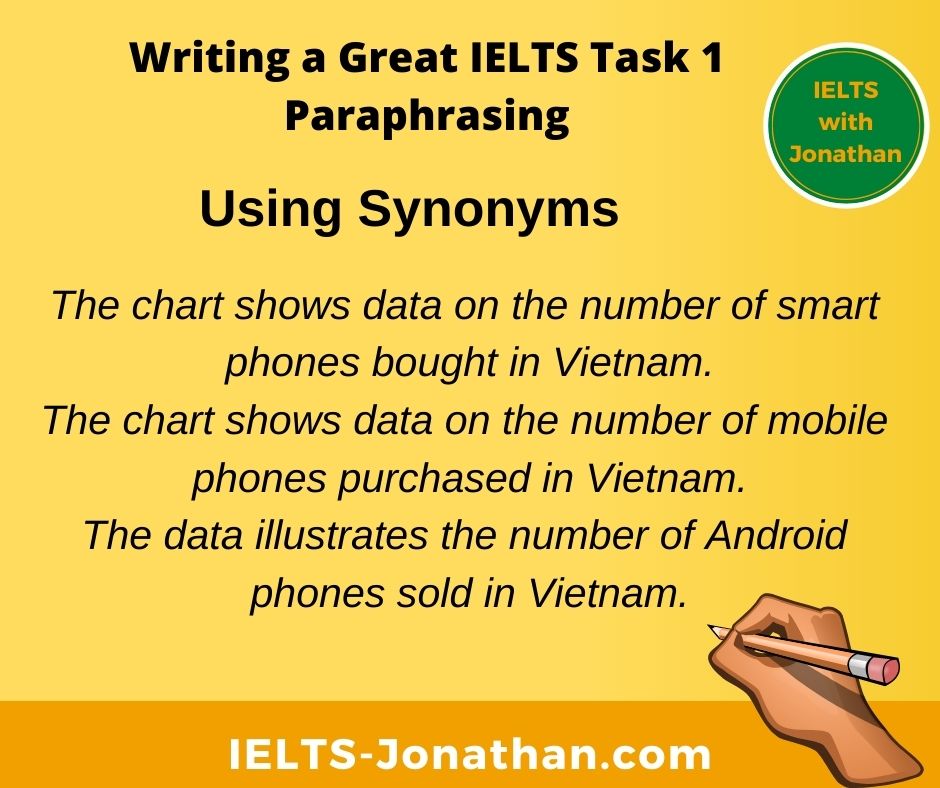
The chart shows data on the number of smart phones bought in Vietnam. The chart shows data on the number of mobile phones purchased in Vietnam. The data illustrates the number of Android phones sold in Vietnam.
Another way to paraphrase is to use phrases like ‘how much’, ‘how many’ and ‘how’.
Look at these examples and compare.
- The pie chart shows the amount of money students’ spent on living expenses. The amount of money / how much money
The pie chart shows how much money was spent on living expenses by students
- The line graph shows the number of people who emigrated to New Zealand during the last year. The number of people / how many people
The line graph shows how many people emigrated to New Zealand last year.
- The table shows different transport modes used by university students in York. Different transport modes / how students travelled to university
The table shows how students in York travel to the university.
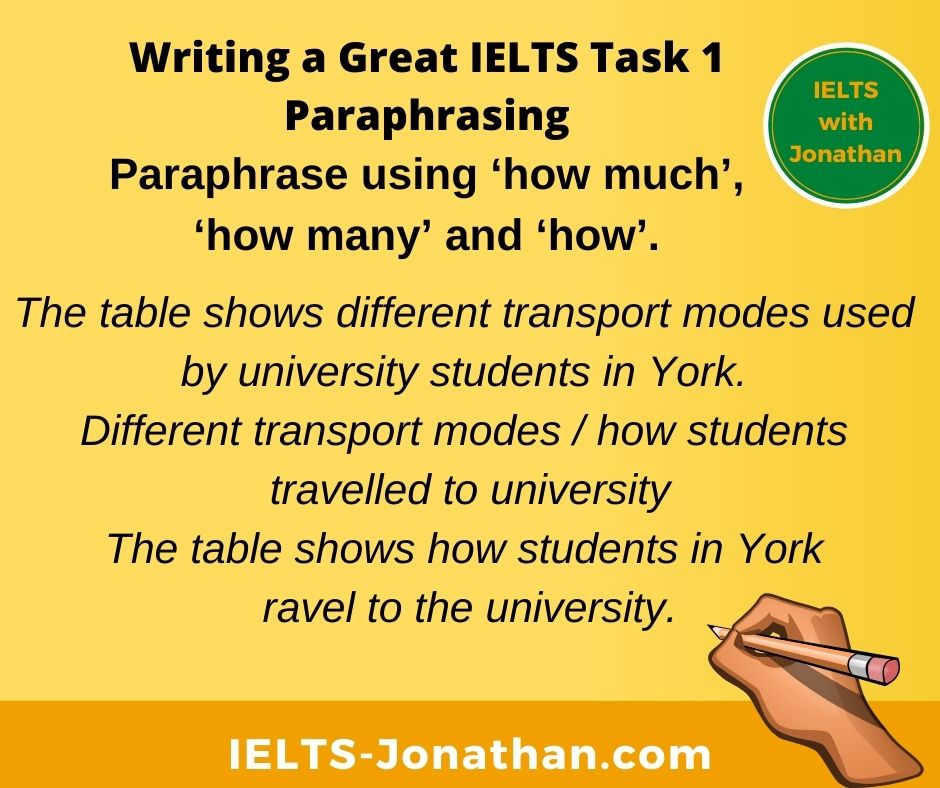
Reporting verbs in IELTS
It is important to have a good range of reporting verbs so you are able to paraphrase the verbs used in the question.
This makes the examiner aware you simply have not copied the topic question.
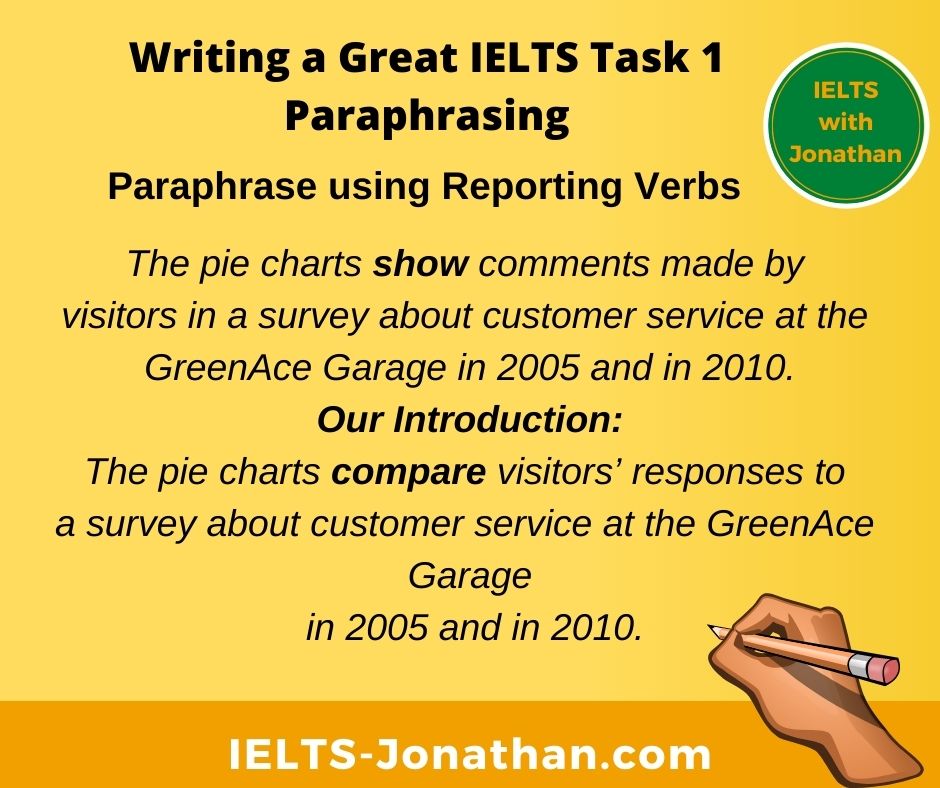
Look at the examples below and the notice the change of verb has been paraphrased.
The pie charts show comments made by visitors in a survey about customer service at the GreenAce Garage in 2005 and in 2010.
Our Introduction :
The pie charts compare visitors’ responses to a survey about customer service at the GreenAce Garage in 2005 and in 2010.
The line graph below shows changes in the amount and type of fast food consumed by British teenagers from 2005 to 2015.
Our introduction:
The chart illustrates changes in the amount and type of fast food consumption by British teenagers between 2005 to 2015.
The graph shows the use of high-speed broadband internet in Korea from 1980 to 2010.
Our Introduction:
The graph compares the consumption of high-speed broadband internet in Korea in the period 1980 to 2010.
The graph shows how the internet is distributed between users of different income levels in China between 2003 to 2006.
The bar graph provides information about the distribution of internet users according to income level in China over three consecutive years.
The diagram below shows the average hours of unpaid work per week done by women.
Our Introduction:
The table illustrates how much unpaid work is done by women on average each week.
Set Phrases to Paraphrase
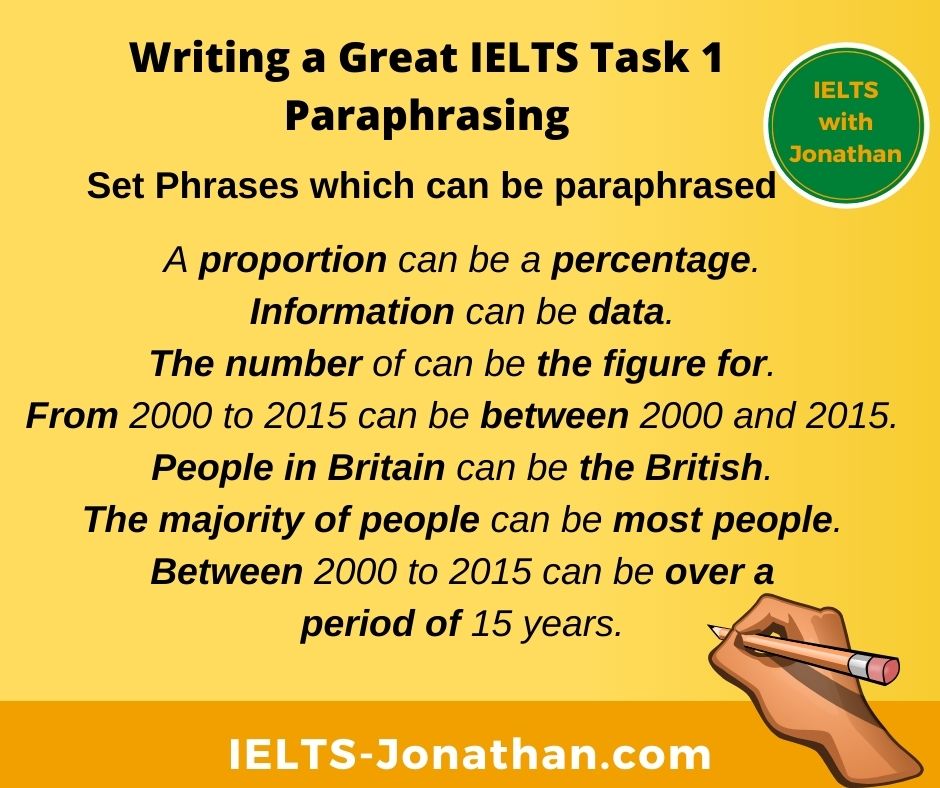
Finally, just look at how simply you can paraphrase by replacing keywords.
You can see how using synonyms helps you paraphrase the introduction.
I recommend that you use a vocabulary journal to note any new words you learn and try paraphrasing when you are practicing IELTS WRITING TASK 1.
A graph can be a line chart, a bar chart or chart.
A chart can be line graph, a bar graph or a bar graph .
A diagram can be a figure and a figure can be a diagram.
Shows can be illustrates if there is a comparison.
A proportion can be a percentage.
Information can be data.
The number of can be the figure for.
The proportion of can be the figure for.
People in Britain can be the British.
The majority of people can be most people.
From 2000 to 2015 can be between 2000 and 2015.
Between 2000 to 2015 can be over a period of 15 years.
How to deliver can be the process of delivery.
In three countries can be in the UK, Germany and France.
Test yourself

How many synonyms can you think of for these three words?
Don’t use a dictionary and remember a synonym is not the exact meaning, but a similar one.
Synonyms (informal):
Synonyms (formal):
Global warming
Some suggestions;
Synonyms (informal): To get, To grab st quickly, to get a good deal, to get a good bargain, to pick st up.
Synonyms (formal): Purchase, acquire, consume (consume and consumption are useful to describe larger economic trends for Writing Task 1)
Synonyms: Environmental issues, harmful pollution, greenhouse effect, the warming of the planet.
Synonyms: Explore, go on an adventure, take an adventure, go on an excursion, get away, take a break, take along break, take a short break.
How was this post? I hope you found it useful.
Comment below if you have any questions.
In Task 1, candidates are asked to describe some visual information a graph, table, chart or diagram. You need to write 150 words in about 20 minutes and you must not copy the question for your introduction.
I’m Jonathan
I’ve taught IELTS and University English in more than a dozen universities and schools around the world.
I’m a parent, traveller and passionate about language teaching and helping students achieve their dreams.
Whilst living in Austria or working in Asia, I run IELTS courses to help students get to where they want to be.
If you are serious about IELTS, connect with me to see how I can help you.

Reader Interactions
11 August 2023 at 1:04 am
Thanks it was very helpful to me
Was this helpful? Leave a comment :) Cancel reply
Let me help you get the ielts result you need.
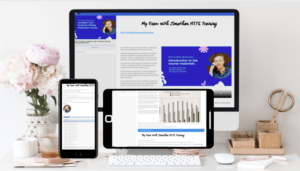
JUST WRITING FEEDBACK

Speaking Feedback
IELTS TRAINING
IELTS FEEDBACK
YOUR PRIVACY
TERMS AND CONDITIONS
IELTS Preparation with Liz: Free IELTS Tips and Lessons, 2024
- Test Information FAQ
- Band Scores
- IELTS Candidate Success Tips
- Computer IELTS: Pros & Cons
- How to Prepare
- Useful Links & Resources
- Recommended Books
- Writing Task 1
- Writing Task 2
- Speaking Part 1 Topics
- Speaking Part 2 Topics
- Speaking Part 3 Topics
- 100 Essay Questions
- On The Day Tips
- Top Results
- Advanced IELTS
Improving IELTS Writing Task 1 Introduction
This lesson focuses on improving your IELTS writing task 1 introduction for the academic paper. To write an introduction you must paraphrase and re-write the information given by IELTS about the chart of graph.
Below is a sample line graph sent to me by an IELTS Candidate.
The line graph below shows the number of overseas students who came from six Asian countries to study in Australia from 1994 to 1997.

Source: Graph above was not created by IELTS Liz.
Introduction Paragraphs for Writing Task 1
Below are two introductions written by the IELTS candidate. Would you use one of these introductions or would you write a different introduction?
Introduction 1 : The diagram shows the amount of students from six different countries in Asia, who came to study in Australia between 1994 and 1997.
Introduction 2: Between 1994 and 1997 the number of Asian students from six different countries, who came to study in Australia.
- Do they cover all the necessary information?
- Are there any errors in them?
- How you would write your introduction to the line graph above?
- How many paragraphs would you have for your complete report for the above line graph?
Feel free to post your answers. However, please note I do not common on writing.
Answers and Model Introduction
Complete the questions above. Then click below to reveal the answers and model introduction paragraph.
- They both cover most of the important information. However, they are lacking the list of countries. Where possible include the list, unless it is too long.
- A line graph is a line graph. Those words should not be paraphrased.
- Always try to paraphrase the verb “shows”.
- The word “amount” is for uncountable nouns, not for countable nouns. We can use this word with “people” or “students”. See this page: Uncountable Nouns
- The line graph illustrates how many students from six different countries in Asia (Japan, Singapore, Hong Kong, Malaysia, Indonesia and Korea) went to Australia to study over a period of four years between 1994 and 1997.
You should have 4 paragraphs: introduction, overview, body paragraph A and body paragraph B.
In body paragraph A, you can put information about Singapore, Malaysia, Indonesia and Korea. In body paragraph B, you can put information about Japan and Hong Kong because they showed different trends from the others.
IELTS Writing Task 1 Free Lessons & Tips
Click below to open all my free lessons and tips for task 1:
IELTS Writing Task 1 Free Lessons
………………..
Subscribe for Free to get New Posts by Email
Type your email…
The provided line graph depicts the influx of students from six Asian nations (Japan, Singapore, Hong Kong, Malaysia, Indonesia and Korea) to pursue their education in Australia during the period from 1994 to 1997.
The line chart illustrate the amount of external students came to study in Australia from a various countries in Asia namely ( Japan , Singapore, Hong gong , Malaysia, Indonesia and Korea ) between 1994 to 1997.
The report compares the count of forgien students ,who came from 6 different Asian countries to study in Australia between 1994 and 1997 , along with representing the changes that took place in the figure over the period
Hello liz, I want to ask if it is possible to write 5 paragraphs instead of 4, if i can’t do that can i write the overview with the introduction in the same paragraph so i can write 3 body paragraphs ?
You can have 5 paragraphs for academic writing task 1, but it isn’t often needed. The most common is two body paragraphs.
The rendered line graph depicts the count of international students from six different asian countries(Japan,Singapore,Malaysia,Hong Kong,Korea) to study in Australia from the year 1994 to 1997.
I’m glad you posted this intro. Here is a list of thing to avoid and change: 1. “rendered” – don’t overuse vocab. This is a factual, straightforward report. “The line graph depicts” is suitable for report writing. Don’t try to full your writing with unnecessary language. 2. “the count” – this isn’t a suitable paraphrase in this context. If you want to change “the number” use “how many” instead. 3. “asian” should have a capital letter 4. you only listed five countries – you missed Indonesia 5. when you write a list, make sure you use “and” between the last two = Japan, Singapore, Malaysia, Hong Kong, Indonesia AND Korea 6. the final words of your intro are a direct copy. Change it up a bit – for the purpose of studying .. Here is an correct version of your introduction:
The line graph depicts how many foreign students went to Australia from six different countries in Asia (Japan, Singapore, Malaysia, Hong Kong, Indonesia and Korea) for the purchase of studying between 1994 and 1997.
As you can see, I’ve also altered the order of information slightly. Try to keep things accurate and simple. Avoid copying more than five words directly in the same order from the task given. If you can’t paraphrase, change the order of information.
The graph illustrates that how many overseas students came from 6 different countries Japan , Singapore , Hong kong ,Malaysia ,Indonesia and Korea to Australia from 1994 to 1997.
Overall , highest no. of students come from Korea in the year of 1994 . The lowest no. of students come from Singapore in 1994 .
In terms of Singapore ,Japan and Malaysia , in the year of 1994 no. of students came from Singapore is just above the 7000 , in Japan it was slightly above 9000 and in Malaysia it was slightly below 11000 . In Singapore and Malaysia no. of students gradually increasing over the period from 1994 to 1997 , but in Japan no. of students increases gradually upto 1996 , but it decreases steeply from 1996 to 1997 . In the final year Singapore ends with just above 13000 students , Japan slightly above 11000 students and from Malaysia no. of students came to Australia for studying was just above 15000 .
In terms of Korea , Indonesia and Hong Kong , in 1994 no. of students came from each countries to Australia for studying are slightly above 9000 in Korea , 11000 in Indonesia and in Hong Kong it was just below 15000 . No. of students from Korea are continuously increasing from 1994 to 1996 but from 1996 to 1997 it decreases and in the final year it was approximately 16000 students , whereas from Indonesia no . of students continuously increasing from 1994 to 1997 . In Hong Kong it was steeply decreased the no. of students till 1996 , from 1996 it was increased just above 13000
please check my answer if possible !
The line graph illustrates foreign students studying in Australia between 1994 and 1997, that were from six different Asian countries. The Asian countries represented were Japan, Singapore, Hong Kong, Malaysia, Indonesia, and Korea.
All the countries except Hong Kong had an increase in the number of students coming to study in Australia, from 1994 to 1996. After 1996 the number of students traveling from Korea and Japan to Australia to study decreased in number, while those from the remaining four Asian countries increased.
In 1994 the highest number of overseas students were from Hong Kong, as these were close to 15000 in number, whereas those from the other Asian countries ranged from about 8000 to 11000 in total from each country. This was followed by a steady growth in the number of students from each of the countries except Hong Kong, with the number for students from Korea peaking up to almost 21000 in total, whereas those from Hong Kong decreased to around 13000 in 1996.
However, between 1996 and 1997 the total of overseas students continued to increase, with the exception of Korea and Japan. Despite the decline in the number of overseas students from Korea, Korea and Indonesia had the highest number of overseas students with a total of approximately 18000 students each compared to the other Asian countries whose number of students ranged from about 12000 to slightly above 15000.
This line graph illustrates how many students from Asian countries(Japan, Singapore, Hongkong, Malaysia, Indonesia, Korea) went to Australia to study over four years between 1994 to 1997.
Overall, all countries except Hongkong had an increase in the number of students coming to Australia, from the year 1994 to 1996. After 1996 the two countries(Japan, Korea) gradually decrease in the number of students coming to Australia while the other four countries are increased.
In 1994 the highest number of students was from Hongkong as they were close to 15000 in number. Whereas other countries were ranged closes to 800 and equals to 11000. this shows steady growth in many students except for the Hongkong and with many students peeking 21000 from North Korea.
However, between 1996 and 1997 there was an increase in the number of students who are coming to Australia from all Asia countries except japan and Korea these countries were dipped about 50% in their students. Despite the declining of students from Korea and Japan, Korea has the highest number of students with a total of approximately 24000 students each compared to other Asian countries
The line graph illustrates the number of international students who joined australia’s universities/colleges from 6 different asian countries (Japan,Singapore, Hongkong ,Malasiya,Indonesia and korea) between 1994 and 1997
Here is my answer: The line graph illustrates how many students who came from six different countries (Japan, Singapore, Hong Kong, Malaysia, Indonesia and Korea) to study in Australia between 1994 and 1997.
The line graph illustrates how many students attended to Australia in the purpose of study from six Asian countries between 1994 and 1997.
Hello Ma’am,
It’s been a first query of mine on this website. It will be very helpful to me if you reply on this as my exam is on 23rd November 2019.
I have written below Introduction of this line graph. Please evaluate it and let me know my mistakes.
Thanks a lot in advance
“The graph illustrates the number of international students between 1994 and 1997, who came from six different countries (Japan,…………………….) to study in Australia.”
Waiting for your kind reply.
Here is my answer The six lines graph compares the amount of puplis who came from six Asian countries from 1994 to 1997 to study in Australia. Overall, the amount of the students increased over the given period particularly from Korea and Indonesia.
As is presented, Singapore, Malaysia and Indonesia have an identical trend, they stood at 11000, 10500 and 9800 respectively. A dramatically improve in the number of Indonesia students is recorded to peak at 18200.while, Malaysia and Singapore showed a gradual growing to end up with 16000 and 13800 regarding.
Although Korea and Japan have both started from 9800 in 1994, Korea flourished remarkably to reach the trough of 20000 in the mid of 1996 whereas Japan was just above 13000, 1997 witnessed fall down.
In contrast, Hong Kong remained steadily above 14000 despite the downward of the mid 1996.
Your reply is highly appreciated 😊
Dear Liz, In your usual kindness, do please help me check my take on this. I will be glad to read your comment as it will aid my improvement. Thank you Chinenye
The line graph illustrates how many students from six Asian countries ( Japan, Singapore, Hong Kong, Malaysia, Indonesia and Korea)that traveled to study in Australia from 1994 to 1997.
Overall, Korea citizens formed the highest population of Asian students in Australia while Singapore accounted for the least. Furthermore, there was a continuous increase of students from Asian continent over the period given.
Singapore and Malaysia started off at about 7,500 and 9,500 students in 1994 respectively and they both recorded steady increase of about 2,000 students per year, while the Indonesian population increase for the four year period fluctuated within the range of 2,000 to 3,800.
In addition, Korea and Japan students were about 9,500 in 1994, climbed rapidly and peaked at above 20,000 and 13,000 before a sharp decline to slightly above 18,000 and 12,000 in the final year respectively. On the other hand, students from Hong Kong were above 14,000 in the first year, decreased to 12,500 in 1996 before an upward surge to shortly below 14,000 at the end.
Just to share my answers with others, here is my answer after the introduction. From what I learned from the other posts, I need to cover most of the information in the graph, but it exceeds 190. Any ideas?
Overall, there was an increase in the number of studnets from four countries (Malaysia, Korea, Indonesia and Singapore) while the figure dropped over the frist three years regarding Hongkong and Japan.
There was constant increase in Malaysian students to around 16000. Similarly, the number of students from Indonesia and Singapore rose gradually over given period. However, the number of Singaporean students was the lowest at around 8000 in 1994 while Indonesian students were the second largest number of 110000 at the start of the period. Regarding Korean students, it began at around 10000 and rose dramatically by double in 1996. From that point, the figure dropped slightly the next year.
On the other hand, there were the most students from Hongkong in 1994 and this figure fell gradually in the following three years before increasing to around 14000 in 1997. There were just over 9000 Japanese students in 1994 and it increased constantly to a high of approximately 13500 in 1996, which then declined to 12000 at the end of the period.
Hello Mam, It been my first qerry ever in this website. I would like to know about short and quick writing tips for both the tasks. How would I decorate my writing tasks I & II with the use of lucrative vocabs ? Is there any marks deduction on handwriting ? Please enlighten me on this part, because my exam is on 2nd august 2018. I need your assistance for other sections too. Regards UDIT
There are lots of pages of free information, advice and tips on this site. See these pages: https://ieltsliz.com/ielts-writing-task-1-lessons-and-tips/ and https://ieltsliz.com/ielts-writing-task-2/ and https://ieltsliz.com/ielts-help-faq/ You should not be filling your writing with descriptive language. You should use appropriate language. For Writing Task 2, I suggest you get my Ideas for Topics E-book which contains both ideas and vocabulary for over 150 common topics, see my online store. Click here: ONLINE STORE
Speak Your Mind Cancel reply
Notify me of new posts by email.
Advanced IELTS Lessons & E-books

Recent Lessons
Ielts liz personal update 2024, ielts model essay -two questions essay type, ielts bar chart of age groups 2024, ielts topic: urban planning, ielts listening transcripts: when and how to use them, 2024 ielts speaking part 1 topics.

Click Below to Learn:
- IELTS Test Information
Copyright Notice
Copyright © Elizabeth Ferguson, 2014 – 2024
All rights reserved.
Privacy Policy & Disclaimer
- Click here: Privacy Policy
- Click here: Disclaimer
Return to top of page
Copyright © 2024 · Prose on Genesis Framework · WordPress · Log in
Need to retake one skill? IELTS One Skill Retake is here.
- IELTS tests IELTS Academic IELTS General Training IELTS UKVI IELTS One Skill Retake LEARN ABOUT THIS TEST What is IELTS Academic? How can I book an IELTS test? Reschedule or cancel an IELTS test Find a test centre WAYS TO TAKE IELTS ACADEMIC IELTS on paper IELTS on computer IELTS Online IELTS One Skill Retake LEARN ABOUT THIS TEST What is IELTS General Training? How can I book an IELTS test? Reschedule or cancel an IELTS test Find a test centre WAYS TO TAKE IELTS GENERAL TRAINING IELTS on paper IELTS on computer IELTS One Skill Retake LEARN ABOUT THIS TEST What is IELTS UKVI? How to book an IELTS UKVI test? Reschedule or cancel an IELTS test Find a test centre WAYS TO TAKE IELTS UKVI IELTS on paper IELTS on computer LEARN ABOUT THIS TEST What is IELTS One Skill Retake? How to book IELTS One Skill Retake? Reschedule or cancel an IELTS test Where is IELTS One Skill Retake available? READ MORE ABOUT IELTS ONE SKILL RETAKE Who accepts IELTS One Skill Retake? How do you get your IELTS One Skill Retake results? FIND THE RIGHT TEST IELTS for study IELTS for work IELTS for migration
Get your results
Check your provisional IELTS results online and do more.

IELTS Writing Task 2: How to write a good introduction
Introductions are an important part of a Writing Task 2 essay. They let your examiner know what to expect from your essay. That’s why we have put together a quick list of tips you can use to write an effective introduction for Writing Task 2.
Content Tags
An introduction is important to the essay because it creates an initial impression in terms of the quality of your writing. A clear, well-organised and relevant introduction will most certainly create a positive first impression on the examiner. So, what makes up an effective introduction? Let’s take a look.
Tip 1: Stop to read and analyse the question
In Writing Task 2, you need to address all the parts of the question or task in a relevant way. Because your introduction is the first step towards achieving this goal, you need to introduce your answer to all the different parts of the question. This is why it is important to take some time to read and analyse the task before you start writing, so you know exactly what you are being asked to write about.
Tip 2: Begin with a general statement and then focus in on the details of the question
Writing Task 2 questions usually begin with a general statement before focusing in on more specific points or questions about the topic. Using a similar model in your own introduction is a great way to start your essay, but make sure that your general statement is clearly related to your topic and is not too broad.
Tip 3: Use your own words
While it is perfectly acceptable for you to use the task as a guide for your introduction, make sure you do not copy material from the task.
Copying the task word-for-word shows the examiner that you have a limited range of language, which can affect your band score. Instead, change the order of the information, use synonyms, and explain more complex ideas in your own words.
It is also important not to use a memorised introduction where you insert words related to the question topic. Examiners read thousands of responses so can recognise memorised scripts.
Tip 4: State your position
In Writing Task 2, you will need to develop a position while exploring the different parts of the task. It is then important that you clearly state your position in your introduction.
Tip 5: Explain how you plan to develop your essay
Even though this strategy can be considered as optional, briefly explaining how you plan to develop the topic can help you better organise your writing. It is also a good way to let the examiner know what you’ll be covering in the essay.
Review your introduction
Don’t forget to re-read your introduction once you’ve finished writing your essay. It is common for test takers to begin their essays thinking about a specific argument, or a specific way to organise their writing but change their minds as they develop the topic. So, after completing your Writing Task 2, make sure that your final draft still matches your introduction.
Now that we have gone over some important strategies for writing a good introduction for Writing Task 2, it’s time to look at a sample introduction. Start by reading and analysing the prompt, as mentioned in tip 1. Then, carefully read the sample introduction and notice the different strategies used, which have been highlighted for you.
Sample question
The threat of nuclear weapons maintains world peace. Nuclear power provides cheap and clean energy.
The benefits of nuclear technology far outweigh the disadvantages.
To what extent do you agree or disagree?
Give reasons for your answer and include any relevant examples from your own knowledge or experience.
Write at least 250 words.
Sample introduction
General Statement:
Nuclear technology has been around for many years.
Details:
Whether this technology is used for weapons of mass destruction or as a source of energy, many are of the belief that the use of nuclear energy has more advantages than disadvantages.
Position:
In my opinion, nuclear technology can indeed be a very efficient energy source. However, nuclear weapons possess such enormous destructive power that any benefits that this technology may offer to humankind are not enough to counter its potential devastating effects.
Plan:
This essay will address why the drawbacks of nuclear technology outweigh the benefits and will include relevant examples to support this position.
Just as an effective introduction will let the examiner know what they can expect from your essay, a good conclusion will remind them of the main points presented and will summarise what you want your examiner to remember from your writing. Check our blog for our post on strategies for writing a good conclusion!
Share this article
7 myths about the IELTS Writing test to dispel
The A to Z of IELTS: G is for Grammatical Range and Accuracy
IELTS Assist – get feedback on your work
IELTS Academic Writing Task 1: How to get a band 7 or higher in task achievement
Feminine and masculine words in English
The A to Z of IELTS: J is for Justification
Grammar 101: Understanding verb tenses
Grammar 101: Subjects and Objects in English
The most common punctuation marks in English
Grammar 101: How to use who and whom correctly?
- Useful links
- Who accepts IELTS?
- News and articles
- IELTS Events
- IELTS Masterclass
- Your IELTS results
- IELTS Academic
- IELTS General Training
- IELTS by IDP app
- Find a test centre
- Middle East
- Netherlands
- New Caledonia
- New Zealand
- Papua New Guinea
- Philippines
- Saudi Arabia
- Solomon Islands
- South Korea
- Switzerland
- Legal notices
- Privacy policy
- Cookie policy
- Copyright 2024 IDP IELTS
- Aug 24, 2023
IELTS Writing Task 2: How to Write the Introduction Paragraph
Updated: Apr 7
There are many ways to write an introduction paragraph but a simple and tested technique is the following:
1. Paraphrase the question (use synonyms/ different parts of speech/ different word order etc.).
2. For questions which ask for your opinion - give your opinion.
3. Outline your 2/ 3 main ideas (which will be in body paragraphs 1 & 2).
Let’s look at an IELTS Writing Task 2 question and use this format to write the introduction paragraph:
Some people argue that we are born with a fixed personality while others argue that we develop our personality because of our experiences.
What do you think is the most important factor?
1. Paraphrase the IELTS Question
A. use the passive:.
One of the best ways to begin is to change the active “some people believe” to the passive, “it is believed by some people” or vice-versa.
b. Use a similar, but different verb:
Verbs such as “argue”, “believe”, or “think” are interchangeable in this context. So, if the question says, “Some people believe ”, you can write “It is argued by some people”, or just, “ It is often argued ”.
c. Use synonyms
In the rest of the sentence, look for synonyms which can replace words in the question. For example, “fixed” becomes “determined” , “develop” becomes “forms” , “personality” becomes “character” , and “because” becomes “due to” .
d. Change parts of speech or word order
You can also change parts of speech, word order or grammatical structure. For example, we develop our personality… becomes the development of our personality…
2. Give Your Opinion (usually required)
A. completely agree/ disagree with one side.
Most IELTS questions ask for your opinion. The easiest way to write an IELTS essay that asks for your opinion is to completely agree (or disagree) with one side. In this case you can use one of the following phrases in your introduction:
I totally agree…
I completely agree…
I strongly believe...
I firmly believe...
For example:
I strongly believe that our personalities are decided by our upbringing and the events in our lives.
I firmly believe that we are born with our characters and they are not changed by circumstances.
If you are not so good at writing, this is a good way to write the essay because your opinion will be very clear (which is important for band 7 and higher for Task Response in IELTS Writing Task 2).
b. Partially agree with both sides
However, if you want to say that you partially agree with more than one side, you can use the following phrases:
I somewhat agree…
I partially agree…
I somewhat agree that we are born with innate characteristics. However, I also think that our upbringing affects how our personalities develop.
If you use this approach, make sure that you write in a very clear way. Often this approach causes problems because the examiner becomes confused about what the writer's opinion is. Make sure that you show that you partially agree with both sides in the introduction and conclusion. Be consistent.
c. Argue both sides, but support one side more
An advanced approach that works for both questions that ask for your opinion, and questions which ask you to discuss both sides, is to argue both sides, but support one side more.
You can do this by using a contrast adverb (or adverbial phrase) such as while , although , and however .
In my opinion, while genetics do play an important role, what happens in our lives is the most important factor in the development of our personalities.
Although we are born with some fixed characteristics, our upbringing is a more important factor in how our personality develops.
Using this approach, you can give both sides of the argument, but show that you support one side more by saying that it is more important. This is the most advanced approach.
3. Outline your 2/ 3 main ideas
At this point you already need to know the 2 or 3 main ideas in your essay. For the essay above I have chosen the following:
Main Idea 1: Genetics create a starting point for our personalities.
Main Idea 2: But experiences have a bigger impact on how our personality develops.
As you can see I am taking an advanced approach and showing I partially agree with both arguments. So, to outline these main ideas, I could write:
"While genetics do play an important role, it is what happens in our lives, particularly in our childhoods, that is the most important factor in the development of our personalities."
Putting it all together
If we put this all together we have the following introduction:
"It is believed by some people that personality is determined at birth, but others think that our character is formed due to the experiences we have. In my opinion, while genetics do play an important role, it is what happens in our lives, particularly in our childhoods, that is the most important factor in the development of our personalities."
To read my whole model answer for this essay look here: IELTS Writing Task 2: 8. Personality (fastforwardielts.com)
- IELTS Writing Task 2
Recent Posts
The IELTS Writing Task 2 Band 8 Checklist
Writing Task 2 - How to Avoid Informal English in Academic Writing
IELTS Writing Task 2: How To Answer Problem/ Cause & Solution Questions To Reach Band 9
- What can IELTS do for you
- Ways to take IELTS
- Who accepts IELTS?
- Sample test questions
- IELTS Trial Test
- Understanding your score
- Trust IELTS
- On test day
- Test centres
- IELTS One Skill Retake
- Cancellations, refunds...
- Access arrangements
- Getting and sharing...
- Improving your results
- Academic Institutions
- Why accept IELTS?
- IELTS Scoring
- Compare IELTS
- IELTS for your sector
- Get started with IELTS
- Verifying IELTS results
- Research reports
- Test statistics
- Research funding
- Awards and scholarships
- Previously funded...
- News and Insights
Need help finding something? Enter a search term below
Writing test preparation resources
Now you can see exactly what you need to do to achieve your IELTS writing goals.
We are excited to launch a series of videos to explain the key criteria for how the Writing tests are scored. This will help you achieve your IELTS goals sooner.
Examiners use assessment criteria to award a score for each of the following four criteria:
- Task achievement (for task 1) and task response (for task 2)
Coherence and cohesion
Lexical resource.
- Grammatical range and accuracy.
Each task is assessed independently. The criteria are weighted equally and the score on the task is the average. The assessment of Task 2 carries more weight in marking than Task 1.
Find out more about the key assessment criteria and how examiners assess the Writing section .
Watch the following series about how your IELTS Writing test is marked for useful information to help you prepare.
General introduction to IELTS Writing
Learn about the IELTS Writing test and get an overview of what will be assessed. This video introduces the Writing tasks and marking criteria, which be covered in more detail in the following videos.
Task achievement for Writing task one – Academic
Discover what to cover in your answer to this task. This video includes the selecting and highlighting of key features as well as providing sufficient detail to illustrate these features. It also discusses using an appropriate format, presenting an overview and reporting information accurately.
Coming soon
Task achievement for writing task one – general training.
Find out about the key areas to cover in your letter. This video discusses addressing the bullet points, explaining the purpose of the letter and using an appropriate format and tone.
Task response (Writing task two)
Learn about the key areas to cover in your essay. This video discusses writing in an appropriate format and providing a clear opening and position as well as a logical conclusion. It also emphasizes the importance of including relevant main ideas, which are extended and supported.
Learn how the organisation of your information and ideas is assessed. This video covers paragraphing, logical sequencing within paragraphs, substitution, referencing and linking devices.
Discover how your vocabulary is assessed. This video covers topics such as vocabulary range, precision, appropriacy and accuracy as well as spelling and word formation errors.
Grammatical range and accuracy
Learn how your grammar is assessed. This video covers sentence forms, grammatical errors and punctuation.

Preparation resources
Free sample test questions, practice papers and resources to help you succeed.

Your test, your way
When you are ready so are we. Our tests are available online and in person at test centres across the globe.
- Accessibility
- Legal & policies
2024. IELTS is jointly owned by the British Council; IDP IELTS; and Cambridge University Press & Assessment

How to Write Introduction for Writing Task 1
We have all appeared for examinations during our school and college days, and most of our examinations were written so writing an answer is not something that is alien to us. However, the challenge in the IELTS is using the correct vocabulary along with structuring your answer well.
The introduction is where your structuring starts and it is also the part you will begin using your vocabulary.
How to structure your introduction?
The introduction should begin by talking about what the graph/bar/table talks about. Ideally, you need to begin with one or two sentences that state what the IELTS writing task 1 shows.You can do this by paraphrasing the title of the graph and by making sure you put in a time frame if there is one.
The question says:
The line graph below shows changes in the amount and type of fast food consumed by Australian teenagers from 1975 to 2000.
And you can paraphrase the question by saying:
The line graph given here compares the fast food consumption for a period of 25 years between 1975 and 2000, of teenagers in Australia
In this way, you have managed to say the same thing as the title, but in a different way.
The sentence following this can be a small overview stating what the main trend(s) in the graph are. You don’t have to provide in depth details as this statement will only cover description of what is happening overall
For example, continuing with the same graph used above, the second statement in your answer could be:
Overall, the consumption of fish and chips declined over the period, whereas the amount of pizza and hamburgers that were eaten increased.
This covers the main changes that took place over the whole period.
If you noticed, the example here used words and phrases like “the graph given here” and “declined”, “increased” and so on. The usage of such words in the introduction is as important as structuring the introduction correctly is.
So, let us now learn such words too!
What kind of vocabulary to use in the introduction?
Introductory phrases:.
The graph/table shows/indicates/illustrates/reveals/represents…
It is clear from the graph/table…
It can be seen from the graph/table…
As the graph/table shows,…
As can be seen from the graph/table,…
As is shown by the graph/table,…
As is illustrated by the graph/table,…
From the graph/table it is clear….
Vocabulary (words) that can be used in the introduction paragraph:
A word of caution.
1. Avoid using phrases like “We can see from the graph…”
2. The phrase according to generally means that the information has come from another person or source, therefore avoid using phrases like “according to the graph….”
Hence, both the structuring and the kind of vocabulary used in the introduction are important because these will pave the way for the rest of your answer. This is the part where the examiner will start the assessment of your writing skills and therefore you need to make sure it is written in the best possible way and as per the IELTS norms.
Share with friends
Scan below qr code to share with your friends, related ielts tips.

Letter Writing: Explaining a Situation
Letter Writing – Explaining a Situation One of the most common...

IELTS Writing Task 1 Analysis (Accident in Supermarket) – Band 5
Let us try to analyse IELTS writing task 1 response by a student. Question: You...

How to Paraphrase?
How to Paraphrase? What is meant by paraphrasing? Paraphrasing...

How to Identify Which Type of IELTS Writing Task 2 Essay is being Asked?
There are so many different types of essays in IELTS Writing...

Some organisations believe that their employees should dress smartly
Some organisations believe that their employees should dress smartly. Others...
Thank you for contacting us!
We have received your message.
We will get back within 48 hours.
You have subscribed successfully.
Thank you for your feedback, we will investigate and resolve the issue within 48 hours.
Your answers has been saved successfully.
Add Credits
You do not have enough iot credits.
Your account does not have enough IOT Credits to complete the order. Please purchase IOT Credits to continue.


An Introduction To IELTS Writing Tasks
All You Need To Know To Understand The Requirements Of The IELTS Writing Test, General and Academic.
(Click image to enlarge)
Read the rest of this page and then go straight to guides for each of these test areas here:
How To Do IELTS Academic Writing Task 1
How To Do IELTS General Writing Task 1
How To Do IELTS Writing Task 2 General and Academic
IELTS Writing Assessment Criteria
Both IELTS Writing General and Academic, task 1 and task 2 are marked according to four very similar criterion, namely:
♦ Task Achievement – 5 ( full explanation )
♦ Coherence and Cohesion – 6 ( full explanation )
♦ Lexical Resource – 6 ( full explanation )
♦ Grammar Range and Accuracy – 7 (coming soon)
But What Does That Mean For YOU?
Well, it means you have to do those 4 things very well to get high bands. But, what exactly do they mean?
You can see exactly what these 4 criterion mean in the official mark schemes here:
IELTS Writing Task 1 Band Descriptors (General and Academic)
IELTS Writing Task 2 Band Descriptors (General and Academic)
However, as you can see, they are not easy to understand!
Understanding them though, is one of the keys to success in IELTS writing, as it means you can give the examiners exactly what they want.
What IELTS Examiners Want To See…
Here is my more user friendly version of what the examiners want to see in your writing:
- Task Achievment
- Coherence and Cohesion
- Lexical Resource
Did you answer all parts of the question? Or did you just focus on the part of the question you liked best, or did you completely forget the second part?
If you did then you have not fully answered the question and your score will not be as high as it could be.
Did you develop your answers enough? Did you add clear explanations and examples where appropriate. A short response is unlikely to be fully developed enough for bands 6 and up.
Have you organised your ideas in a logical manner and in a sensible order?
This generally means using paragraphs to group ideas and starting and finishing with an introduction and conclusion. Using topic sentences also helps greatly here.
Are you using a range of vocabulary or are you repeating the same words again and again?
For example, instead of repeating the word ‘athlete’ you could say: sportsmen (or women), professional sports-players, elite level competitors and so on.
Doing this demonstrates your range of vocabulary and scores higher grade bands.
Are you using the correct form of the word?
There is a big difference between the words: environment, environmental, environmentalist and environmentalism, can you use the correct form at the right time, with the right spelling?
Do you have a mix of simple and complex sentences?
The world we live in is amazing. The world we inhabit is amazing, it has a wide variety of species of both plants and animals and furthermore it has an ever changing climate adding to the diversity
I ELTS Writing Band Scores
Your writing band score for each task is worked out by adding together your score (remember it is out of 9) for each of the 4 criteria explained above and dividing it by 4. For example:
♦ Task Achievement – 5
♦ Coherence and Cohesion – 6
♦ Lexical Resource – 6
♦ Grammar Range and Accuracy – 7
The overall band score for that task would be: 6 (5+6+6+7 = 24 and 24/4 = 6).
It is important to understand therefore that each of the criteria are just important as the others!
So, do not focus just on improving your grammar, you need to focus on all four aspects to improve your score most rapidly.
IELTS Writing Strategies
It is important to become familiar with the different types of writing tasks that you may face. Even if your written English is already very good the writing tasks are trickier than they first look and need practicing.
The good news is they all follow a similar pattern, there are 5 different styles of IELTS task 2 essays to write (see info-graphic above) and all IELTS Academic writing part 1 questions involve describing/summarizing or explaining a graph, chart, table, diagram or flow chart and IELTS General writing part 1 requires a letter..
Becoming familiar with each of these is not so tricky, and will make you more relaxed in the exam. It also prevents you from making any silly mistakes like misunderstanding the question instructions if you have tackled that style of question previously.
More Good News…
Further good news is that there are 10 common topics that come up time and time again in all parts of the test. This means that if you focus your vocabulary building and practice around these topics it will be highly likely to improve your band score.
The Most Common IELTS Topics:
1. Technology
3. Development
4. Government Spending
5. Environment
6. Globalization
7. Youth Crime
8. Criminal Justice
9. Education
10. Public Transport
If you read newspaper article and magazines about these topics it will help you formulate your own thoughts and opinions so you will not be short of ideas on test day.
So, if part 2 and 3 of your speaking test are about one of these topics you will already have a good idea of what to say and of the appropriate vocabulary and phrases to use.
You may also be able to remember points from the articles to use as examples in your essay main body paragraphs. That’s another good reason to watch the news and documentaries in English on an ongoing basis.
Overall repetition and practice of the different types of questions and having an experienced IELTS teacher give you feedback is the best way to prepare for your exam.
Free Practice/Sample IELTS Writing Materials General And Academic
Writing Practice Test General And Academic – British Council
Writing Practice Test Samples General And Academic – IELTS.org
Writing Practice Tests General And Academic – IDP Australia
IELTS Writing Task 1 (Academic)
Discover how to describe all types of visual data that you may see in this part of the test.

IELTS Listening
Sshhhhh! Listen closely, here are some valuable tips, techniques and strategies for maximising your listening band score.

IELTS Writing Task 1 (General)
Discover how to write in the correct format and tone for this part of the test.

IELTS Speaking
Learn 'what' to say and 'how' to say it in each part of the test to impress the examiner.

IELTS Writing Task 2
Discover the 5 step process for writing band 7 essays in 40 minutes or less.

IELTS Reading
Here we reveal the best method for completing each part of the reading test.
Copyright 2017 - IELTS Freeway - All Rights Reserved
Powered by OptimizePress 2.0
Welcome Guest!
- IELTS Listening
- IELTS Reading
- IELTS Writing
- IELTS Writing Task 1
- IELTS Writing Task 2
- IELTS Speaking
- IELTS Speaking Part 1
- IELTS Speaking Part 2
- IELTS Speaking Part 3
- IELTS Practice Tests
- IELTS Listening Practice Tests
- IELTS Reading Practice Tests
- IELTS Writing Practice Tests
- IELTS Speaking Practice Tests
- All Courses
- IELTS Online Classes
- OET Online Classes
- PTE Online Classes
- CELPIP Online Classes
- Free Live Classes
- Australia PR
- Germany Job Seeker Visa
- Austria Job Seeker Visa
- Sweden Job Seeker Visa
- Study Abroad
- Student Testimonials
- Our Trainers
- IELTS Webinar
- Immigration Webinar
A Simple System That Turns Dirty Water Into Clear Water – IELTS Writing Task 1 Academic Process Diagram
Updated On Apr 22, 2024

Share on Whatsapp
Share on Email
Share on Linkedin
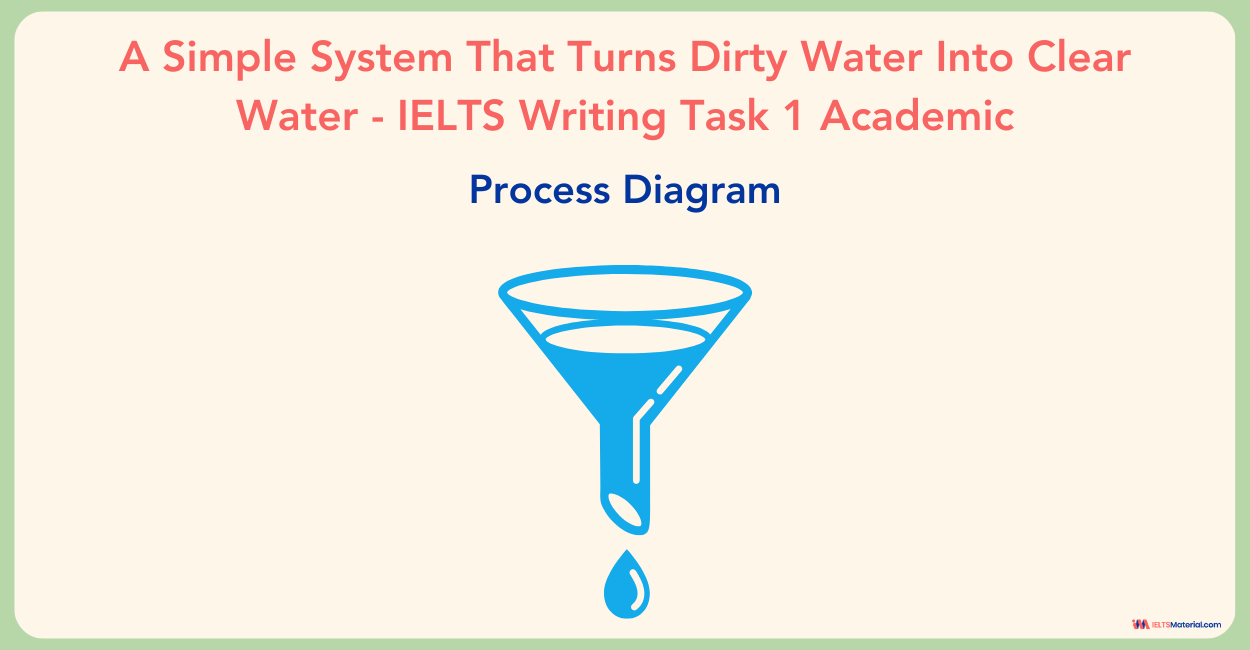
Limited-Time Offer : Access a FREE 10-Day IELTS Study Plan!
Table of Contents [ Show ]
Answer Structure For IELTS Writing Task 1 Academic Process Diagram
Band 7 sample answer for writing task 1 question – ‘a simple system that turns dirty water into clear water’, band 8 sample answer for writing task 1 question – ‘a simple system that turns dirty water into clear water’, band 9 sample answer for writing task 1 question – ‘a simple system that turns dirty water into clear water’.
In the following blog on IELTS Writing Task 1 Academic – Process Diagram on the topic ‘A Simple System That Turns Dirty Water Into Clear Water’, we’ll delve into strategies for effectively approaching the Process Diagram question, including analyzing the visual information, structuring your response, and using appropriate vocabulary and transitions.
Whether you’re just starting your IELTS preparation or looking to refine your writing skills, this blog post will help you tackle the Process Diagram with confidence.
Check out how to solve IELTS Writing Task 1 Academic – Process Diagram !
Learn more about IELTS Writing Task 1 Academic !
By following this general structure, you can effectively describe and explain process diagrams in a clear and organized manner, ensuring that the reader understands the sequence of steps, their interconnectivity, and the final outcome.
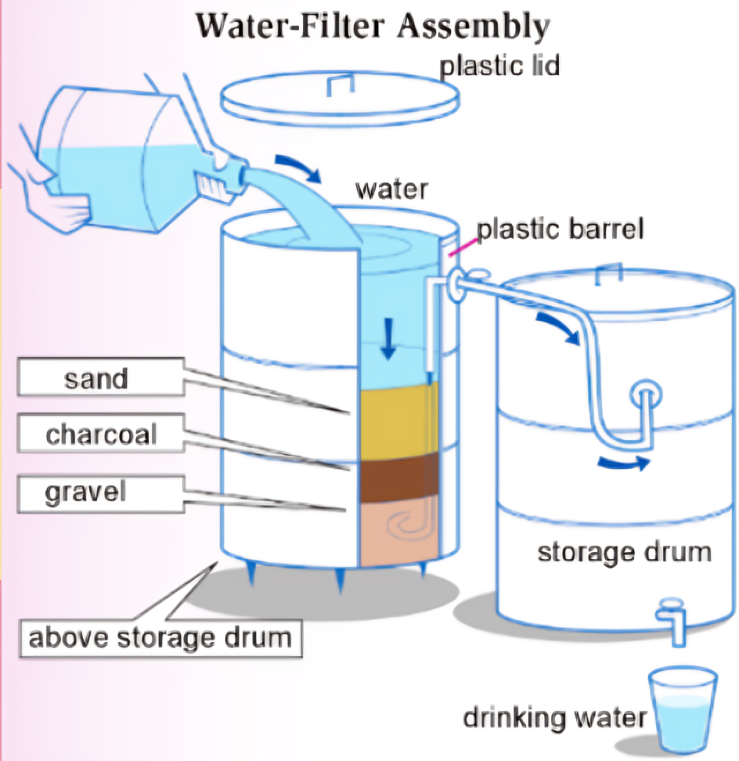
The diagrams illustrate a straightforward water purification system comprising two vessels—one for filtration and the other for storage—utilizing natural materials in a layered configuration to eliminate contaminants.
The water filter assembly consists of a plastic barrel with a lid to prevent contamination during the process. The barrel’s interior is divided into three sections containing layers of sand, charcoal, and gravel. Beneath the filtration barrel is a storage drum that serves as a reservoir for the filtered water. This drum is strategically positioned to collect water exiting the filtration tank and is equipped with a tap at its base for dispensing the purified water.
The purification process commences by pouring the contaminated water into the filtration barrel, where it first encounters the sand layer. Subsequently, the water permeates through the charcoal layer, which plays a crucial role in removing dissolved impurities due to its adsorption properties. The final gravel layer not only filters out any remaining larger particles but also regulates the water flow into the storage drum. The filtered water travels from the barrel to the drum through a connecting pipe. Once in the storage drum, the water is ready for consumption and can be accessed through the tap. (199 words)
Vocabulary For Band 7 Answer
- Contaminants: Impurities or pollutants that make something impure or unclean.
- Adsorption: The process of attracting and holding molecules or particles from a gas, liquid, or dissolved solid onto the surface of a solid material.
- Permeates: To pass through or penetrate something, especially gradually or with difficulty.
- Strategically: In a way that is carefully planned to achieve a particular goal or purpose.
- Configured: Arranged or structured in a particular way.
- Commences: To begin or start something.
- Encounters: To meet or experience something, especially unexpectedly or by chance.
- Eliminates: To remove or get rid of something completely.
- Regulates: To control or maintain a particular state or condition.
- Accessed: To obtain or retrieve data or information from a particular source.
The given diagrams illustrate a simple yet ingenious system designed to purify water using natural filtration methods. The setup consists of two main components – a plastic filtration barrel and a storage drum positioned beneath it to collect the filtered water.
The filtration barrel is segmented internally into three distinct layers. The top layer comprises sand, which serves as the initial filter, trapping larger sediments and particulate matter as the unclean water is poured into the barrel. The middle layer is composed of charcoal, a highly effective adsorbent capable of removing dissolved impurities and improving the water’s taste and odor.
Lastly, the bottom layer consists of gravel, which not only filters out any remaining solid particles but also controls the flow rate of the water as it exits the filtration barrel. A pipe connects the bottom of the barrel to the storage drum, allowing the filtered water to flow smoothly into the reservoir. The storage drum, positioned strategically below the filtration barrel, is equipped with a tap at its base. This tap enables easy access to the purified water, making it readily available for consumption or other intended uses.
Overall, this low-cost and sustainable water filtration system effectively employs the natural properties of sand, charcoal, and gravel to remove contaminants progressively, transforming unclean water into a safe, potable resource. (218 words)
Vocabulary For Band 8 Answer
- Ingenious: Clever, original, and inventive.
- Adsorbent: A material that attracts and holds molecules or particles from a gas, liquid, or dissolved solid onto its surface.
- Sediments: Solid particles that settle at the bottom of a liquid.
- Particulate matter: A mixture of solid particles and liquid droplets found in the air or other gases.
- Impurities: Unwanted substances or contaminants that make something impure or unclean.
- Odor: A smell, especially an unpleasant one.
- Reservoir: A natural or artificial place where liquid is collected and stored.
- Potable: Safe to drink; drinkable.
- Consumption: The act of using up or ingesting something.
- Sustainable: Able to be maintained or continued at a certain rate or level.
The diagrams depict an ingenious yet straightforward water purification system that harnesses the intrinsic properties of natural materials to eliminate impurities and render water potable. The assembly comprises two integral components: a plastic filtration barrel and an underlying storage drum, judiciously positioned to facilitate the collection of filtered water.
The filtration barrel is a meticulously designed vessel, internally compartmentalized into three distinct layers, each serving a specific purpose in the purification process. The topmost stratum consists of sand, a granular medium that effectively captures larger particulate matter and sediments as the contaminated water is introduced into the barrel.
Subsequent to this initial filtration, the water percolates through the middle layer, comprised of charcoal, a highly porous and adsorptive material renowned for its ability to remove dissolved impurities, improving the water’s organoleptic properties, such as taste and odor. The final layer, a bed of gravel, not only acts as a polishing filter, eliminating any residual solid particles, but also regulates the water’s flow rate as it exits the filtration barrel. A strategically placed pipe connects the bottom of the filtration barrel to the storage drum, facilitating the seamless transition of the filtered water into the reservoir.
Overall this ingenious system, characterized by its simplicity and sustainability, exemplifies the judicious exploitation of natural materials’ inherent properties, progressively eliminating contaminants and transforming unclean water into a safe, potable resource, thereby addressing a fundamental human need in an eco-friendly and cost-effective manner. (238 words)
Vocabulary For Band 9 Answer
- Intrinsic: Belonging naturally; essential.
- Judiciously: With good judgment or wise decision-making.
- Stratum (plural: strata): A layer or level of material, typically one of a series of layers.
- Percolate: To filter or pass through a porous surface or substance gradually.
- Adsorptive: Having the property of adsorbing or attracting and holding molecules or particles onto a surface.
- Organoleptic: Relating to the sensory properties of a substance, such as taste, smell, and color.
- Polishing filter: A final filtering stage that removes any remaining impurities or particles.
- Seamless: Smooth and continuous, with no rough edges or joints.
- Exploit: To make use of and derive benefit from a resource or situation.
Get Better At Writing Process Diagram Answers With Our Book – Buy Now !
Also, Check:
- The Diagrams below Show the life cycle of the Silkworm and the Stages in the Production of Silk Cloth- IELTS
- Process of Making Pulp and Paper Diagram Writing Task 1 Answers
- Academic IELTS Writing Task 1 Recycling process of wasted glass bottles Sample Answers
- Water Cycle Diagram – IELTS Academic Writing Task 1 Answers
- IELTS Academic Writing Task 1 Topic 09 : Consequence of deforestation – Flow Chart
Practice IELTS Writing Task 1 based on report types

Start Preparing for IELTS: Get Your 10-Day Study Plan Today!
Raajdeep Saha
Raajdeep Saha, an MBA graduate in Marketing from IMT Ghaziabad and holder of a BCA degree from The Heritage Academy, boasts three years of experience as a Senior Content Marketing Specialist. His focus lies in crafting persuasive content for IELTS, CELPIP, and TOEFL. Simultaneously, he's an accomplished author and poet, with his published work, "OUSHQ," showcasing his literary prowess. He seamlessly marries his marketing acumen with creative storytelling, making him a versatile professional of both corporate and artistic distinction.
Post your Comments
Recent articles.

Kasturika Samanta
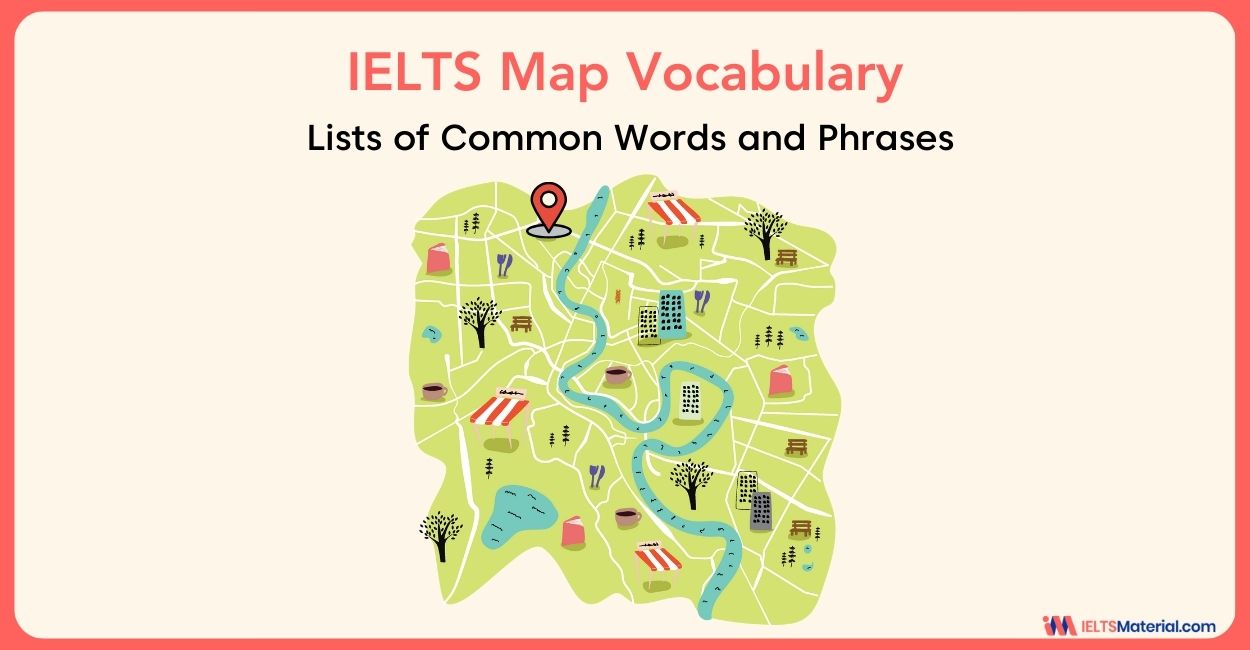
Our Offices
Gurgaon city scape, gurgaon bptp.
Step 1 of 3
Great going .
Get a free session from trainer
Have you taken test before?
Please select any option
Get free eBook to excel in test
Please enter Email ID
Get support from an Band 9 trainer
Please enter phone number
Already Registered?
Select a date
Please select a date
Select a time (IST Time Zone)
Please select a time
Mark Your Calendar: Free Session with Expert on
Which exam are you preparing?
Great Going!
4 March 2024 IELTS Writing Task 2 Question
Share this article:
About the video
Struggling with IELTS Writing Task 2?
Our latest video has you covered! We break it down step by step, making it easy to understand.
Get expert tips, strategies, and real examples to boost your skills.
Watch our 4 March 2024 IELTS Writing Task 2 video now and enroll in our IELTS online coaching for personalized support and free IELTS practice tests . Don't miss out on acing your IELTS exam!
Share this video:

- Writing Correction
- Online Prep Platform
- Online Course
- Speaking Assessment
- Ace The IELTS
- Target Band 7
- Practice Tests Downloads
- IELTS Success Formula
- Essays Band 9 IELTS Writing Task 2 samples – IELTS Band 9 essays
- Essays Band 8 IELTS Writing – samples of IELTS essays of Band 8
- Essays Band 7 IELTS Writing – samples of IELTS essays of Band 7
- Essays Band 6 IELTS Writing – samples of IELTS essays of Band 6
- Essays Band 5 IELTS Writing – samples of IELTS essays of Band 5
- Reports Band 9 IELTS Writing – samples of IELTS reports of Band 9 (Academic Writing Task 1)
- Reports Band 8 IELTS Writing – samples of IELTS reports of Band 8
- Reports Band 7 IELTS Writing – samples of IELTS reports of Band 7
- Letters Band 9 IELTS Writing Task 1 – samples of IELTS letters of Band 9
- Letters Band 8 IELTS Writing – samples of IELTS letters of Band 8
- Letters Band 7 IELTS Writing – samples of IELTS letters of Band 7
- Speaking Samples
- Tests Samples
- 2023, 2024 IELTS questions
- 2022 IELTS questions
- 2021 IELTS questions
- 2020 IELTS questions
- High Scorer’s Advice IELTS high achievers share their secrets
- IELTS Results Competition
- IELTS-Blog App
Latest IELTS questions from Taiwan – April 2024 (Academic Module)
- Recent IELTS exams
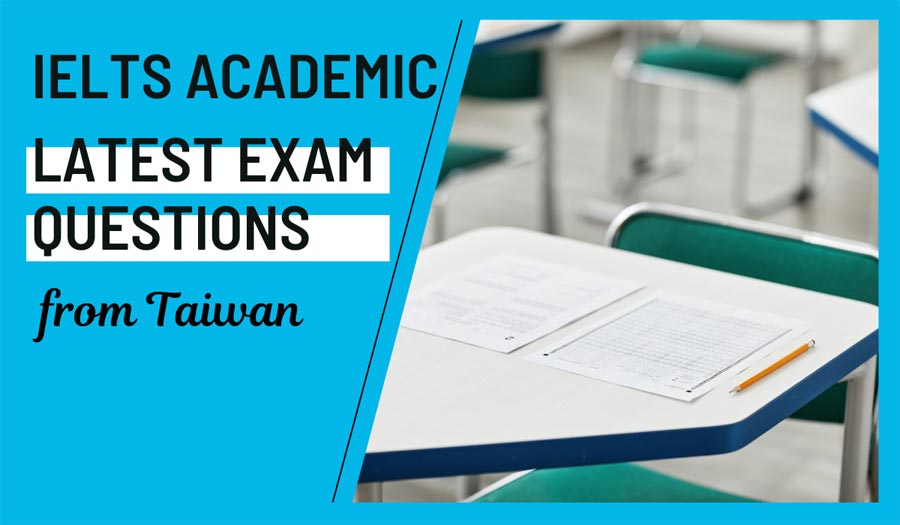
Our student A has taken IELTS in Taiwan very recently and remembered the following writing questions:
Writing test
Writing task 1 (a report)
The bar chart below shows the percentages of population aged 65 or above in three countries in 1980, 2000 and a prediction for 2030.
Summarise the information by selecting and reporting the main features, and make comparisons where relevant.
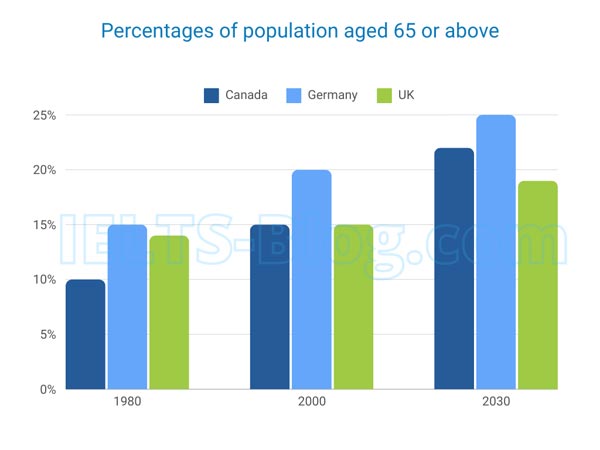
* Note: this isn’t the original chart given in the test, it was recreated for the purpose of demonstration.

Writing task 2 (an essay)
Some people think that robots are very important to humans’ future development, but others think that they are dangerous and have negative effects on society.
Discuss both views and give your own opinion.
Related posts:
- Latest IELTS questions from the UAE – April 2024 (Academic Module) Our student ZA has taken IELTS in the UAE very...
- Latest IELTS questions from India – April 2024 (Academic Module) Thanks to our kind student, today we are sharing the...
- Latest IELTS questions from the UK – January 2024 (Academic Module) Our subscriber MZ told us about his IELTS exam in...
- Latest IELTS questions from India – January 2024 (Academic Module) Our subscriber MS told us about her IELTS exam in...
- Latest IELTS questions from Vietnam – February 2024 (Academic Module) Our student MN took IELTS in Vietnam and remembered the...
Leave a Reply
Your email address will not be published. Required fields are marked *
Save my name, email, and website in this browser for the next time I comment.

how to describe a walk around a park - ielts academic writing task 1 map
拒绝无用留学,提高GPA成绩!
How to Summarize (with examples)
Syllable structure: What are onset, nucleus & coda? | Phonology
Singular and Plural Nouns - s, es, and ies endings
Tone vs. Intonation
IELTS Writing Task 1 Academic Cam 16 Band 9 Sample + Student Writing Reviews
PHONETICS-5: Places of Articulation发音部位
Lecture: Intonation - form and function; the tone unit (Part 3 of 3)
Summary vs. Synthesis: What's the Difference?
IELTS Cam 17 Academic Writing Task 1 (Test 1) + Band 9 Sample剑17小作文
The Last Lexical Item Rule (LLI) | Sentence Stress & Intonation | Phonology
PHONETICS-9: Maximal Onset Principle & English Phonotactics最大声母原理与英语语音实践
PHONETICS-12: Sonority & Syllabic Consonants 12:元音和音节辅音
What is pitch? 音高- Frequency in Hertz | Intonation in English | Phonology
PHONETICS-11: A Special Case for the Sonority Sequencing Principle响度排序原理的一个特例
Introduction to Linguistics_ First Lecture
APOSTROPHE | English grammar | How to use punctuation correctly
《西游记》Journey to the west英语视频 精读课1
Connotation VS. Denotation
Synthesis: Definition & Examples
PHONETICS-6: Manner of Articulation发音方式

IMAGES
VIDEO
COMMENTS
You should start your task 1 answer by introducing the graph from your question. Just write 1-2 sentences to say what your graph shows and for what period of time (if there is one). To do this, you need to paraphrase text from your task 1 question. Example of good introduction: Question: The graphs below give information about computer ...
An introduction paragraph for an IELTS writing task 2 essay requires only two statements. A Background Statement - This is a paraphrase of the essay question. All essays must have this statement. A Thesis Statement - A direct answer to the essay question and task.
Procedure: introduce focus of the lesson: Writing Task 2 - Essay structures and introductions. give each student a copy of Worksheet 1 and one minute to read the Task 2 question. elicit possible next steps before writing i.e. brainstorming ideas. draw attention to the True / False task and clarify the importance of spending time with the ...
Tip 1: Stop to read and analyse the question. In Writing Task 2, you need to address all the parts of the question or task in a relevant way. Because your introduction is the first step towards achieving this goal, you need to introduce your answer to all the different parts of the question. This is why it is important to take some time to read ...
In the writing for task 2, you must write an IELTS essay introduction, but you only have 40 minutes. In this time you need to analyze the question, brainstorm ideas to write about, formulate an essay plan, and then write your response. Even for a native writer of English, this is a lot to do in 40 minutes! So you need to use your time carefully.
If you practice enough, introductions will become easy, and you will do them in just a few minutes. This will leave you lots of time to focus on the main body paragraphs, where you can pick up lots of marks. An IELTS writing task 2 opinion essay should have three elements, and these should be: Paraphrase question. Give opinion.
Essentially, what you do need to do is: Introduce the topic. Assert a position and/or explain the purpose of your essay. To do this, I think that the best way to write an introduction is to paraphrase the question and then write a thesis statement. Let's look at these in detail.
In IELTS writing task 2, the introduction and the conclusion are two of the most misunderstood paragraphs.Test takers often write too much or too little. Sometimes they struggle to write anything at all. Many students overthink these paragraphs, especially the introduction, and try to write all the most impressive grammar and vocabulary they know.
Success in IELTS writing task 2 is based on using the right techniques. These free tips, model essays, lessons, videos and information will help develop the skills for writing task 2. This page will teach you how to maximise your IELTS writing task 2 score. All lessons are on this page are for both GT and Academic writing task 2.
Though IELTS Writing Task 2 topics can vary widely, you can still use the same basic IELTS Writing Task 2 introduction vocabulary to introduce your ideas. Here, I'll use the following sample prompt to show words you can use for all types of prompts, as well as examples of how you could respond to this prompt specifically.
An IELTS writing task 2 introduction should contain a paraphrase of the rubric (the task statement) and a thesis statement. Paraphrasing the task statement shows examiners that you understand the task and what you are required to write. Do not copy from the rubric as this will be deducted from your word count. Limit the paraphrase to 1 sentence.
Getting started, or writing an introductory paragraph, can be easy if you remember that an introduction has four purposes: Introduce the topic of the essay. Arouses the reader's interest in the topic. Indicates the overall "plan" of the essay. Tells reader what the essay is about. In the IELTS writing exam, the examiners are not looking ...
Download PDF: https://bit.ly/course-slides-previewLearn how to write a perfect introduction to your IELTS Writing Task 2 essay using my easy 3-sentence formu...
IELTS Writing Task 2 is the second part of the writing test, where you are presented with a point of view, argument or problem and asked to write an essay in response. Your essay should be in a formal style, at least 250 words in length and you should aim to complete it in under 40 minutes. ... The introduction is the first thing the examiner ...
This will leave you lots of time to focus on the main body paragraphs where you can pick up lots of mark. An IELTS writing task 2 opinion essay should have three sentences and these three sentences should be: Paraphrase question. Thesis statement. Outline statement.
Crafting a compelling introduction and conclusion is very important in IELTS Writing task 2, as they serve as the gateway to engage the reader and leave a lasting impression.A strong introduction captures the reader's attention, establishes the topic's relevance, and presents a clear thesis statement, while a well-crafted conclusion provides a concise summary of the main points and offers a ...
The introduction is the first section that the examiner sees when your writing is marked. It is important to create a good impression in terms of language and purpose. There are often two simple points to make when writing an IELTS Task 1 introduction; namely, what is the point of the information and what is the numerical information.
You should write over 150 words. IELTS writing task 1 is worth only about 33% of your total writing marks. Academic writing task 1 is a report on a chart (bar chart, line graph, pie chart, table, map, diagram/process). See below for practice charts, model answers, tips etc. General Training writing task 1 is a letter only.
This lesson focuses on improving your IELTS writing task 1 introduction for the academic paper. To write an introduction you must paraphrase and re-write the information given by IELTS about the chart of graph. Below is a sample line graph sent to me by an IELTS Candidate. The line graph below shows the number of overseas students who came from ...
IELTS Writing Task 2: How to write a good introduction. ... Now that we have gone over some important strategies for writing a good introduction for Writing Task 2, it's time to look at a sample introduction. Start by reading and analysing the prompt, as mentioned in tip 1. Then, carefully read the sample introduction and notice the different ...
1. Paraphrase the IELTS Question. a. Use the passive: One of the best ways to begin is to change the active "some people believe" to the passive, "it is believed by some people" or vice-versa. b. Use a similar, but different verb: Verbs such as "argue", "believe", or "think" are interchangeable in this context.
General introduction to IELTS Writing. Learn about the IELTS Writing test and get an overview of what will be assessed. This video introduces the Writing tasks and marking criteria, which be covered in more detail in the following videos. ... Task achievement for Writing task one - General Training. Find out about the key areas to cover in ...
The introduction should begin by talking about what the graph/bar/table talks about. Ideally, you need to begin with one or two sentences that state what the IELTS writing task 1 shows.You can do this by paraphrasing the title of the graph and by making sure you put in a time frame if there is one. The line graph below shows changes in the ...
IELTS Writing Assessment Criteria. Both IELTS Writing General and Academic, task 1 and task 2 are marked according to four very similar criterion, namely: ♦ Task Achievement - 5 ( full explanation) ♦ Coherence and Cohesion - 6 ( full explanation) ♦ Lexical Resource - 6 ( full explanation) ♦ Grammar Range and Accuracy - 7 (coming ...
In the following blog on IELTS Writing Task 1 Academic - Process Diagram on the topic 'A Simple System That Turns Dirty Water Into Clear Water', we'll delve into strategies for effectively approaching the Process Diagram question, including analyzing the visual information, structuring your response, and using appropriate vocabulary and transitions.
An Introduction To IELTS WRITING TASK 2 April 15th 2024 Monday Starts @ 3:00 pm !!! Join Us ...
Struggling with IELTS Writing Task 2? Our latest video has you covered! We break it down step by step, making it easy to understand. Get expert tips, strategies, and real examples to boost your skills. Watch our 4 March 2024 IELTS Writing Task 2 video now and enroll in our IELTS online coaching for personalized support and free IELTS practice ...
Our student A has taken IELTS in Taiwan very recently and remembered the following writing questions: Writing test. Writing task 1 (a report) The bar chart below shows the percentages of population aged 65 or above in three countries in 1980, 2000 and a prediction for 2030.
IELTS Writing Task 1 Academic Cam 16 Band 9 Sample + Student Writing Reviews. joye10. 4 0 PHONETICS-5: Places of Articulation发音部位 ... Introduction to Linguistics_ First Lecture. joye10. 310 0 APOSTROPHE | English grammar | How to use punctuation correctly. joye10. 43 0 ...